Informative Essay — Purpose, Structure, and Examples


What is informative writing?
Informative writing educates the reader about a certain topic. An informative essay may explain new information, describe a process, or clarify a concept. The provided information is objective, meaning the writing focuses on presentation of fact and should not contain personal opinion or bias.
Informative writing includes description, process, cause and effect, comparison, and problems and possible solutions:
Describes a person, place, thing, or event using descriptive language that appeals to readers’ senses
Explains the process to do something or how something was created
Discusses the relationship between two things, determining how one ( cause ) leads to the other ( effect ); the effect needs to be based on fact and not an assumption
Identifies the similarities and differences between two things; does not indicate that one is better than the other
Details a problem and presents various possible solutions ; the writer does not suggest one solution is more effective than the others

Purpose of informative writing
The purpose of an informative essay depends upon the writer’s motivation, but may be to share new information, describe a process, clarify a concept, explain why or how, or detail a topic’s intricacies.
Informative essays may introduce readers to new information .
Summarizing a scientific/technological study
Outlining the various aspects of a religion
Providing information on a historical period
Describe a process or give step-by-step details of a procedure.
How to write an informational essay
How to construct an argument
How to apply for a job
Clarify a concept and offer details about complex ideas.

Explain why or how something works the way that it does.
Describe how the stock market impacts the economy
Illustrate why there are high and low tides
Detail how the heart functions
Offer information on the smaller aspects or intricacies of a larger topic.
Identify the importance of the individual bones in the body
Outlining the Dust Bowl in the context of the Great Depression
Explaining how bees impact the environment
How to write an informative essay
Regardless of the type of information, the informative essay structure typically consists of an introduction, body, and conclusion.
Introduction
Background information
Explanation of evidence
Restated thesis
Review of main ideas
Closing statement

Informative essay introduction
When composing the introductory paragraph(s) of an informative paper, include a hook, introduce the topic, provide background information, and develop a good thesis statement.
If the hook or introduction creates interest in the first paragraph, it will draw the readers’ attention and make them more receptive to the essay writer's ideas. Some of the most common techniques to accomplish this include the following:
Emphasize the topic’s importance by explaining the current interest in the topic or by indicating that the subject is influential.
Use pertinent statistics to give the paper an air of authority.
A surprising statement can be shocking; sometimes it is disgusting; sometimes it is joyful; sometimes it is surprising because of who said it.
An interesting incident or anecdote can act as a teaser to lure the reader into the remainder of the essay. Be sure that the device is appropriate for the informative essay topic and focus on what is to follow.

Directly introduce the topic of the essay.
Provide the reader with the background information necessary to understand the topic. Don’t repeat this information in the body of the essay; it should help the reader understand what follows.
Identify the overall purpose of the essay with the thesis (purpose statement). Writers can also include their support directly in the thesis, which outlines the structure of the essay for the reader.
Informative essay body paragraphs
Each body paragraph should contain a topic sentence, evidence, explanation of evidence, and a transition sentence.

A good topic sentence should identify what information the reader should expect in the paragraph and how it connects to the main purpose identified in the thesis.
Provide evidence that details the main point of the paragraph. This includes paraphrasing, summarizing, and directly quoting facts, statistics, and statements.
Explain how the evidence connects to the main purpose of the essay.
Place transitions at the end of each body paragraph, except the last. There is no need to transition from the last support to the conclusion. A transition should accomplish three goals:
Tell the reader where you were (current support)
Tell the reader where you are going (next support)
Relate the paper’s purpose
Informative essay conclusion
Incorporate a rephrased thesis, summary, and closing statement into the conclusion of an informative essay.
Rephrase the purpose of the essay. Do not just repeat the purpose statement from the thesis.
Summarize the main idea found in each body paragraph by rephrasing each topic sentence.
End with a clincher or closing statement that helps readers answer the question “so what?” What should the reader take away from the information provided in the essay? Why should they care about the topic?
Informative essay example
The following example illustrates a good informative essay format:


Want to create or adapt books like this? Learn more about how Pressbooks supports open publishing practices.
39 Introduction to Informative Writing
Amy Minervini
By Amy Minervini
Exposition is writing that explains, informs, or describes. This type of writing is also known as the informative mode in that the main objective is not to narrate a story or persuade readers of something but rather to convey factual information , including observations and personal/others’ experiences. However, when writing an expository essay, you can include elements from other modes (storytelling, analysis, writer impressions, persuasion, etc.) although these would be secondary aims or even implied. The expository composition is a practical, authentic kind of writing that can stand on its own or serve as the foundation for your more developed research essays.
Key Characteristics
Expository writing generally exhibits the following:
- Emphasis on facts, observations, or personal/others’ experiences
- Organization marked by a logical flow or progression of information; chronological, order of importance/priority, or the step-by-step approach are the most common; transitions that guide the reader
- Close attention paid to detail and description
- No noticeable writer bias
Essay types within this Chapter
- Process analysis (how-to)
- Illustration
Introduction to the General Expository Essay
The following is excerpted from Crystle Bruno’s Commonsense Composition 3.1 Expository Essay
The main aim of an expository essay is to provide an effective explanation of a topic. While a descriptive essay strives to describe a subject or a narrative essay seeks to show personal growth, an expository essay tries to explain a topic or situation. Thus, expository essays are written as if the writer is explaining or clarifying a topic to the reader. Since an expository essay is trying to clarify a topic, it is important that it provides the categories or reasons that support the clarification of the paper. Moreover, these categories and reasons also provide the framework for the organization of the paper.
Components of the expository essay as the parts of a house.
Much like the categories are essential to clarifying the topic, organization is the key to any well-developed essay. When composing your essay, think of its organization as a house, with each component of an essay representing a major part of a house. Just as the foundation provides support on which a house can be built, a thesis represents the foundation upon which to build an essay. The introductory paragraph then functions as both the door and framework for an expository essay. Like a house door, the introductory paragraph must allow the reader to enter into the essay. Additionally, just as walls are built upon the framework of a house, the body paragraphs of an essay are organized around the framework or organizational scheme, presented in the introductory paragraph. The body paragraphs, much like the walls of a house, must be firm, strong and complete. Also, there must always be as many body paragraphs as the framework of the introductory paragraph indicates otherwise your essay will resemble a house that is missing a wall. Finally, an essay must include a conclusion paragraph that tops off the essay much like a roof completes a house. As the roof cements the structure of the house and helps hold the walls in place, the conclusion paragraph must reiterate the points within your body paragraphs and complete an essay.
Although the overall organization of an expository essay is important, you must also understand the organization of each component (the introductory, body and conclusion paragraphs) of your essay. The chart below identifies the essential parts of each component of your essay, explaining the necessary information for each type of paragraph. While the guidelines listed below may feel constrictive, they are merely meant to guide you as a writer. Ultimately, the guidelines should help you write more effectively. The more familiar you become with how to organize an essay, the more energy you can focus on your ideas and your writing. As a result, your writing will improve as your ability to organize your ideas improves. Plus, focusing your energy on your argument and ideas rather than the organization makes your job as a writer more exciting and fun.
Introductory Paragraph:
- Introduce the issue.
- Present the topic and its explanation or clarification.
- Provide the categories used to explain the topic.
- Provide the thesis statement.
Body Paragraphs:
- Begin with a topic sentence that reflects an explanation of the paper and the category being discussed in the paragraph.
- Support the argument with useful and informative quotes from sources such as books, journal articles, etc.
- Provide 2-3 quotes that connect the category being discussed to the explanation
- Provide 2-3 sentences explaining each quote more full, drawing stronger connections between the category and the explanation.
- Ensure that the information in these paragraphs is important to the thesis statement.
- End each paragraph with a transition sentence which leads into the next body paragraph.
Concluding Paragraph:
- Begin with a topic sentence that reflects the argument of the thesis statement.
- Briefly summarize the main points of the paper.
- Provide a strong and effective close for the paper.
Introductory Paragraphs
A strong introductory paragraph is crucial to the development of an effective expository essay. Unlike an argumentative essay which takes a stand or forms an opinion about a subject, an expository essay is used when the writer wishes to explain or clarify a topic to the reader. In order to properly explain a topic, an expository essay breaks the topic being addressed into parts, explains each component in relation to the whole and uses each component to justify the explanation of the topic. Thus when writing an introductory paragraph, it is crucial to include the explanation or clarification of the topic and the categories or components used to produce this explanation.
Since the success of the paper rests on the introductory paragraph, it is important to understand its essential components. Usually, expository papers fail to provide a clear explanation not because the writer’s lacks explanations or clarifications but rather because the explanations are not properly organized and identified in the introductory paragraph. One of the most important jobs of an introductory paragraph is that it introduces the topic or issue. Most explanations cannot be clarified without at least some background information. Thus, it is essential to provide a foundation for your topic before you begin explaining your topic. For instance, if you wanted to explain what happened at the first Olympic Games, your introductory paragraph would first need to provide background information about how the first games happened. In doing so, you ensure that your audience is as informed about your topic as you are and thus you make it easier for your audience to understand your explanation.
Below is a table describing and explaining the main jobs of the introductory paragraph.
Introductory paragraphs introduce the topic and suggest why it is important.
Example: An analysis of the essay exam results of the new English class shows that the new class format promotes close reading and better essay organization.
This sentence tells the reader both that the topic of the paper will be the benefits of the new English class and that the significance of these benefits is the improvement of close reading and essay organization.
Introductory paragraphs outline the structure of the paper and highlight the main ideas.
Example: Considering the results of the High School Exit Exam, it is apparent that school curriculum is not properly addressing basic math skills such as fractions, percentages and long division.
This sentence indicates that main ideas (fractions, percentages and long division) of the essay and indicates the order in which they will be presented in the body paragraphs.
Introductory paragraphs state the thesis.
Example: California high schools will require all students to take a resume and cover letter writing workshop in order to better prepare them for employment.
This thesis statement indicates the explanation of the paper.
In addition to introducing the topic of your paper, your introductory paragraph also needs to introduce each of the arguments you will cover in your body paragraphs. By providing your audience with an idea of the points or arguments you will make later in your paper, your introductory paragraph serves as a guide map, not only for your audience but also for you. Including your main sub-points in your introduction not only allows your audience to understand where your essay is headed but also helps you as a writer remember how you want to organize your paper. This is especially helpful if you are not writing your essay in one sitting as it allows you to leave and return to your essay without forgetting all of the important points you wanted to make.
Most importantly, when writing an introductory paragraph, it is essential to remember that you must capture the interest of your reader. Thus, it is your job as the writer to make the introduction entertaining or intriguing. In order to do so, consider using a quotation, a surprising or interesting fact, an anecdote or a humorous story. While the quotation, story or fact you include must be relevant to your paper, placing one of these at the beginning of your introduction helps you not only capture the attention or the reader but also introduce your topic and argument, making your introduction interesting to your audience and useful for your argument and essay.
Body Paragraphs
In an expository essay the body paragraphs are where the writer has the opportunity to explain or clarify his or her viewpoint. By the conclusion paragraph, the writer should adequately clarify the topic for the reader. Regardless of a strong thesis statement that properly indicates the major sub-topics of the essay, papers with weak body paragraphs fail to properly explain the topic and indicate why it is important. Body paragraphs of an expository essay are weak when no examples are used to help illuminate the topic being discussed or when they are poorly organized. Occasionally, body paragraphs are also weak because the quotes used complicate from rather than simplify the explanation. Thus, it is essential to use appropriate support and to adequately explain your support within your body paragraphs.
In order to create a body paragraph that is properly supported and explained, it is important to understand the components that make up a strong body paragraph. The bullet points below indicate the essential components of a well-written, well-argued body paragraph.
Body Paragraph Components
- Support the argument with useful and informative quotes from sources such as books, journal articles, expert opinions, etc.
- Provide 1-2 sentences explaining each quote.
- Provide 1-3 sentences that indicate the significance of each quote.
- Ensure that the information provided is relevant to the thesis statement.
- End with a transition sentence which leads into the next body paragraph.
Just as your introduction must introduce the topic of your essay, the first sentence of a body paragraph must introduce the main sub-point for that paragraph. For instance, if you were writing a body paragraph for a paper explaining the factors that led to US involvement in World War II, one body paragraph could discuss the impact of the Great Depression on the decision to enter the war. To do so, you would begin with a topic sentence that explains how the Great Depression encouraged involvement in the war because the war effort would stimulate certain aspects of the economy. Following this sentence, you would go into more detail and explain how the two events are linked. By placing this idea at the beginning of the paragraph, not only does your audience know what the paragraph is explaining, but you can also keep track of your ideas.
Following the topic sentence, you must provide some sort of fact that supports your claim. In the example of the World War II essay, maybe you would provide a quote from a historian or from a prominent history teacher or researcher. After your quote or fact, you must always explain what the quote or fact is saying, stressing what you believe is most important about your fact. It is important to remember that your audience may read a quote and decide it is indicating something entirely different than what you think it is explaining. Or, maybe some or your readers think another aspect of your quote is important. If you do not explain the quote and indicate what portion of it is relevant to your clarification, than your reader may become confused or may be unconvinced of your explanation. Consider the possible interpretations for the statement below.
Example: While the U.S. involvement in World War II was not the major contributor to the ending of the Great Depression, the depression was one of the primary motives for entering the war.
Interestingly, this statement seems to be saying two things at once – that the Great Depression helped spark involvement in the war and that World War II did not end the depression alone. On the one hand, the historian seems to say that the two events are not directly linked. However, on the other hand, the historian also indicates that the two events are linked in that the depression caused U.S. involvement in the war. Because of the tension in this quotation, if you used this quote for your World War II essay, you would need to explain that the significant portion of the quote is the assertion that links the events.
In addition to explaining what this quote is saying, you would also need to indicate why this is important to your explanation. When trying to indicate the significance of a fact, it is essential to try to answer the “so what.” Image you have just finished explaining your quote to someone and they have asked you “so what?” The person does not understand why you have explained this quote, not because you have not explained the quote well but because you have not told him or her why he or she needs to know what the quote means. This, the answer to the “so what,” is the significance of your paper and is essentially your clarification within the body paragraphs. However, it is important to remember that generally a body paragraph will contain more than one quotation or piece of support. Thus, you must repeat the Quotation-Explanation-Significance formula several times within your body paragraph to fully explain the one sub-point indicated in your topic sentence. Below is an example of a properly written body paragraph.
Example of an expository body paragraph paired with an explanation of its parts.
Conclusion Paragraph
The conclusion paragraph of an expository essay is an author’s last chance to create a good impression. Hence, it is important to restate the thesis statement at the beginning of the paragraph in order to remind the reader of your topic and explanation. Since it is at the end of the paper, the conclusion paragraph also should add a sense of closure and finality to the clarification of the paper. It is important to re-emphasize the main idea without being repetitive or introducing an entirely new idea or subtopic. While you can conclude your conclusion paragraph by suggesting a topic for further research or investigation, do not make this question the focus of the paragraph. Thus, you should briefly and concisely reiterate the strongest clarifications of the paper, reminding the reader of the validity of your thesis or explanation and bringing closure to your paper.
You may feel that the conclusion paragraph is redundant or unnecessary; However, do not forget that this is your last chance to explain the significance of your argument to your audience. Just as your body paragraphs strive to present the significance of each fact or quote you use, your conclusion paragraph should sum up the significance of your argument. Thus, you should consider making a bold statement in your concluding paragraph by evoking a vivid image, suggesting results or consequences related to your argument or ending with a warning. Through using these components, you not only make your conclusion paragraph more exciting, but you also make your essay and your argument, more important.
Review Questions
What are three of the main purposes of an introductory paragraph?
- What should you never do in an introductory paragraph?
- How should you refute counterpoints?
- What is the formula for a well-argued body paragraph?
- What should you include in a conclusion paragraph? What should never include in a conclusion paragraph?
Introduction to Informative Writing Copyright © 2020 by Amy Minervini is licensed under a Creative Commons Attribution-NonCommercial 4.0 International License , except where otherwise noted.
Share This Book

Writing an Informative Essay
Informative essays engage readers with new, interesting, and often surprising facts and details about a subject. Informative essays are educational; readers expect to learn something new from them. In fact, much of the reading and writing done in college and the workplace is informative. From textbooks to reports to tutorials like this one, informative writing imparts important and useful information about a topic.
This tutorial refers to the sample informative outline and final essay written by fictional student Paige Turner.
Reasons to Write Informatively
Your purpose for writing and the audience for whom you are writing will impact the depth and breadth of information you provide, but all informative writing aims to present a subject without opinions or bias. Some common reasons to write informatively are to
- report findings that an audience would find interesting,
- present facts that an audience would find useful, and
- communicate information about a person, place, event, issue, or change that would improve an audience’s understanding.
Characteristics of Informative Essays
Informative essays present factual information and do not attempt to sway readers’ opinions about it. Other types of academic and workplace writing do try to influence readers’ opinions:
- Expository essays aim to expose a truth about an issue in order to influence how readers view the issue.
- Persuasive essays aim to influence readers’ opinions, so they will adopt a particular position or take a certain course of action.
Expository and persuasive essays make “arguments.” The only argument an informative essay makes is that something exists, did exist, is happening, or has happened, and the point of the essay is not to convince readers of this but to tell them about it.
- Informative essays seek to enlighten and educate readers, so they can make their own educated opinions and decisions about what to think and how to act.
Strategies for Writing Informatively
Informative essays provide useful information such as facts, examples, and evidence from research in order to help readers understand a topic or see it more clearly. While informative writing does not aim to appeal emotionally to readers in order to change their opinions or behaviors, informative writing should still be engaging to read. Factual information is not necessarily dry or boring. Sometimes facts can be more alarming than fiction!
Writers use various strategies to engage and educate readers. Some strategies include
- introducing the topic with an alarming fact or arresting image;
- asserting what is true or so about the subject in a clear thesis statement;
- organizing the paragraphs logically by grouping related information;
- unifying each paragraph with a topic sentence and controlling idea;
- developing cohesive paragraphs with transition sentences;
- using precise language and terminology appropriate for the topic, purpose, and audience; and
- concluding with a final idea or example that captures the essay’s purpose and leaves a lasting impression.
Five Steps for Getting Started
1. Brainstorm and choose a topic.
- Sample topic : The opioid epidemic in the United States.
- The opiod epidemic or even opiod addiction would would be considered too broad for a single essay, so the next steps aim to narrow this topic down.
2. Next, write a question about the topic that you would like to answer through research.
- Sample question : What major events caused the opioid crisis in the United States?
- This question aims to narrow the topic down to causes of the epidemic in the US.
3. Now go to the Purdue Global Library to find the answers to your research question.
As you begin reading and collecting sources, write down the themes that emerge as common answers. Later, in step four, use the most common answers (or the ones you are most interested in writing and discussing) to construct a thesis statement.
- Sample answers: aggressive marketing, loopholes in prescription drug provider programs, and economic downturn.
4. Next, provide purpose to your paper by creating a thesis statement.
The thesis attempts to frame your research question. The sample thesis below incorporates three of the more common answers for the research question from step two: What caused the opioid crisis in the United States?
- Thesis Statement : Aggressive marketing, loopholes in prescription drug provider programs, and economic downturn contributed to the current opioid crisis in the United States.
- Writing Tip : For additional help with thesis statements, please visit our Writing a Thesis Statement article. For help with writing in 3rd person, see our article on Formal Vs. Informal Writing .
5. Now follow each numbered step in the “Suggested Outline Format and Sample” below.
Sample answers have been provided for “I. Introduction” and “II. First Cause.” A complete sample outline can be seen here. A complete sample informative essay can be seen here.
Suggested Outline Format and Sample
I. INTRODUCTION
A. First provide a topic sentence that introduces the main topic: Sample topic sentence : There is a current prescription pain medication addiction and abuse epidemic possibly caused by an excessive over prescription of these medications.
B. Now provide a couple sentences with evidence to support the main topic: Sample sentence one with evidence to support the main topic : According to Dr. Nora Volkow, Director of National Institute on Drug Abuse (NIDA), in testimony before the 115th Congress, “In 2016, over 11 million Americans misused prescription opioids … and 2.1 million had an opioid use disorder due to prescription opioids” (Federal Efforts to Combat the Opioid Crisis, 2017, p. 2).
C. Sample sentence two with evidence to support the main topic : Volkow indicated “more than 300,000 Americans have died of an opioid overdose” since 2013 (Federal Efforts to Combat the Opioid Crisis, 2017, p.2).
D. Sample sentence three with evidence to support the main topic : According to Perez-Pena (2017), the Center for Disease Control and Prevention reported more than 25,000 people in the United States died in 2015 from overdosing on opioids Fentanyl, Oxycodone, and Hydrocodone.
E. Toward the end of the introduction, include your thesis statement written in the 3rd-person point-of-view: Sample thesis statement : Potential solutions to the growing opioid epidemic may be illuminated by examining how opioid addiction is triggered through aggressive pharmaceutical marketing, how opioid addiction manifests among prescribed patients, and how economic downturns play a role in the increase of opioid addiction.
F. Write down the library sources you can use in this introductory paragraph to help support the main topic.
- Federal Efforts to Combat the Opioid Crisis, 2017
- Perez-Pena, 2017
- Writing Tip : For more help writing an introduction, please refer to this article on introductions and conclusions .
II. FIRST CAUSE
A. First provide a topic sentence that introduces the first cause of the opioid epidemic: Sample topic sentence that introduces the first cause : One issue that helped contribute to the opioid epidemic is aggressive marketing by pharmaceutical manufacturers.
B. Now provide sentences with evidence to support the first cause: Sample sentence one with evidence that supports the first cause : Perez-Pena (2017) concluded that while the healthcare industry was attempting to effectively and efficiently treat patients with chronic pain, pharmaceutical companies were providing funding to prominent doctors, medical societies, and patient advocacy groups in order to win support for a particular drug’s adoption and usage.
C. Sample sentence two with evidence to support the first cause : In fact, pharmaceutical companies continue to spend millions on promotional activities and materials that deny or trivialize any risks of opioid use while at the same time overstating each drug’s benefit (Perez-Pina, 2017).
D. Next, add more information or provide concluding or transitional sentences that foreshadows the upcoming second cause: Sample concluding and transitional sentence that foreshadow the second cause : Although aggressive marketing by pharmaceutical companies played a large role in opioid addiction, patients are to blame too, as many take advantage of holes in the healthcare provider system in order to remedy their addiction.
E. Write down the library sources you can use in this body paragraph to help support the first cause:
- Writing Tip : For more assistance working with sources, please visit the Using Sources page here.
III. SECOND CAUSE
A. First provide a topic sentence that introduces the second cause.
B. Now provide sentences with evidence to support the second cause.
C. Next, add more information or provide concluding or transitional sentences that foreshadows the upcoming third cause.
D. Write down the library sources you can use in this body paragraph to help support the second cause:
- Writing Tip : Listen to Writing Powerful Sentences for information and features of effective writing.
IV. THIRD CAUSE
A. First provide a topic sentence that introduces the third cause.
B. Now provide sentences with evidence to support the third cause.
C. Next, add more information or provide a concluding sentence or two.
D. Write down the library sources you can use in this body paragraph to help support the third cause:
V. CONCLUSION: Summary of key points and evidence discussed.
- Writing Tip : For more help writing a conclusion, refer to this podcast on endings .
- Writing Tip : Have a question? Leave a comment below or Purdue Global students, click here to access the Purdue Global Writing Center tutoring platform and available staff.
- Writing Tip : Ready to have someone look at your paper? Purdue Global students, click here to submit your assignment for feedback through our video paper review service.
See a Sample Informative Essay Outline here .
See a sample informative essay here., share this:.
- Click to email a link to a friend (Opens in new window)
- Click to share on Facebook (Opens in new window)
- Click to share on Reddit (Opens in new window)
- Click to share on Twitter (Opens in new window)
- Click to share on LinkedIn (Opens in new window)
- Click to share on Pinterest (Opens in new window)
- Click to print (Opens in new window)
2 Responses
- Pingbacks 0
dang bro i got an A
Having faith with all this mentioned, that i will pass my english class at a college. Thank you for posting.
Leave a Reply Cancel reply
Your email address will not be published. Required fields are marked *
Follow Blog via Email
Enter your email address to follow this blog and receive email notifications of new posts.
Email Address
- RSS - Posts
- RSS - Comments
- COLLEGE WRITING
- USING SOURCES & APA STYLE
- EFFECTIVE WRITING PODCASTS
- LEARNING FOR SUCCESS
- PLAGIARISM INFORMATION
- FACULTY RESOURCES
- Student Webinar Calendar
- Academic Success Center
- Writing Center
- About the ASC Tutors
- DIVERSITY TRAINING
- PG Peer Tutors
- PG Student Access
Subscribe to Blog via Email
Enter your email address to subscribe to this blog and receive notifications of new posts by email.
- College Writing
- Using Sources & APA Style
- Learning for Success
- Effective Writing Podcasts
- Plagiarism Information
- Faculty Resources
- Tutor Training
Twitter feed
How to Write an Informative Essay: Everything You Need to Know

Did you know that informative essays aren't just for school? They're also used in jobs like journalism, marketing, and PR to explain complex ideas and promote things. This shows how useful they are outside of the classroom.
So, if you're planning to write one, that's a great choice! It's interesting but can be tough. To do it well, you need to plan, research, and organize carefully. Keep your tone balanced, give clear info, and add your own thoughts to stand out.
In this guide, our essay writer will give you tips on starting and organizing your essay effectively. At the end, you'll also find interesting essay samples. So, let's jump right into it.
What is an Informative Essay
To give a good informative essay definition, imagine them as windows to new knowledge. Their main job is to teach others about a particular topic. Whether it's for a school project or something you stumble upon online, these essays are packed with interesting facts and insights.
Here's a simple breakdown from our admission essay writing service of what makes an informative essay tick:

- Keeping It Real: These essays are all about the facts. No opinions allowed. We want to keep things fair and honest.
- Topics Galore: You can write about anything you find interesting, from science and history to things about different cultures.
- Where You Find Them: Informative essays can pop up anywhere, from your classroom assignments to the pages of magazines or even online articles.
- Research: Like a good detective, informative essays rely on solid evidence. That means digging into trustworthy sources to gather reliable information.
- Stay Neutral: To keep things fair, informative essays don't take sides. They present the facts and let readers draw their own conclusions.
- Structure: These essays have a clear roadmap. They start with an introduction to set the stage, then present the main points with evidence, and wrap up with a summary to tie it all together.
- Write for Your Audience: Keep your writing simple and easy to understand. Think about who will be reading it.
- Give Just Enough Detail: Don't overload people with info. Find the right balance so it's interesting but not overwhelming.
Ready to Ignite Minds with Your Informative Essay?
Our qualified writers are here to craft a masterpiece tailored to your needs worthy of an A+
Reasons to Write an Informative Essay
Writing informative essays, whether following the IEEE format or another style, is a great way to teach and share ideas with others. Here's why it's worth giving it a try:
.webp)
- Make Complex Ideas Easy : Informative essays simplify complicated topics so everyone can understand them. They break down big ideas into simple parts, helping more people learn and share knowledge.
- Encourage Thinking : When you read these essays, you're encouraged to think for yourself. They give you facts and evidence so you can form your own opinions about different topics. This helps you become better at understanding the world around you.
- Inspire Doing : They can motivate people to take action and make positive changes by raising awareness about important issues like the environment, fairness, or health. By reading these essays, people might be inspired to do something to help.
- Leave a Mark : When you write informative essays, you're leaving a legacy of knowledge for future generations. Your ideas can be read and learned from long after you're gone, helping others understand the world better.
How to Start an Informative Essay
If you're still doubting how to start with an informative essay outline, no worries! Here's a step-by-step guide to help you tackle this task like a pro. Alternatively, you can simply order essay and have it done by experts.

- Choose an Exciting Topic : Pick something that really grabs your attention. Writing about what you're genuinely interested in makes the whole process way more fun. Plus, it's easier to write confidently about things you know a bit about.
- Dig into Research : Spend some quality time digging up info from reliable sources. Take good notes, so you have all the facts you need to back up your essay. The better your research, the stronger your essay will be.
- Set Your Essay's Goal : Decide what you want your essay to do. Are you explaining something, analyzing a problem, or comparing ideas? Knowing your goal helps you focus your writing.
- Sketch Out Your Essay : Make a simple plan for your essay. Start with an intro that grabs attention and states your main idea. Then, map out your main points for the body paragraphs and plan a strong finish for your conclusion.
- Kick Off with an Awesome Introduction : Start with a killer opening line to hook your readers. Give a bit of background on your topic and clearly state your main idea.
- Flesh Out Your Body Paragraphs : In each paragraph, cover one key point backed up with evidence from your research. Keep it clear and simple, and don't forget to cite your sources.
- Wrap Up Strong : Sum up your main points in your conclusion and restate your main idea in a memorable way. Leave your readers with something to think about related to your topic.
Informative Essay Outline
Many students don't realize how helpful outlining can be for writing an informative essay. Spending a bit of time on it can actually save you loads of time later on when you're writing. To give you a head start, here's a simple format from our term paper writing services :
I. Introduction
- Start with something catchy to grab attention
- Give a little background info on your topic
- State your main idea clearly in your thesis statement
II. Body Paragraphs
A. Talk about your first main idea
- Share evidence or facts that support this idea
- Explain what the evidence means
- Transition smoothly to the next point
B. Move on to your second main idea
- Provide evidence or facts for this point
- Explain why this evidence matters
- Transition to the next paragraph
C. Address your third main idea
- Offer supporting evidence or facts
- Explain the significance of this evidence
- Transition to the next part
III. Conclusion
- Restate your thesis statement to remind readers of your main point
- Summarize the key points you've covered in the body paragraphs
- Leave readers with some final thoughts or reflections to ponder
IV. Optional: Extra Sections
- Consider addressing counterarguments and explaining why they're not valid (if needed)
- Offer suggestions for further research or additional reading
- Share personal anecdotes or examples to make your essay more relatable (if it fits)
Informative Essay Structure
Now that you've got a plan and know how to start an essay let's talk about how to organize it in more detail.
Introduction :
In your informative essay introduction, your aim is to grab the reader's interest and provide a bit of background on your topic. Start with something attention-grabbing, like a surprising fact or a thought-provoking question. Then, give a quick overview of what you'll be talking about in your essay with a clear thesis statement that tells the reader what your main points will be.
Body Paragraphs:
The body paragraphs of an informative essay should dive into the main ideas of your topic. Aim for at least three main points and back them up with evidence from reliable sources. Remember the 'C-E-E' formula: Claim, Evidence, Explanation. Start each paragraph with a clear point, then provide evidence to support it, and finally, explain why it's important. Mastering how to write an informative essay also requires smooth transitions from one section to the next, so don't forget to use transition words.
Conclusion :
You may already guess how to write a conclusion for an informative essay, as it's quite similar to other writing types. Wrap up by summarizing the main points you've made. Restate your thesis to remind the reader what your essay was all about. Then, leave them with some final thoughts or reflections to think about. Maybe suggest why your topic is important or what people can learn from it.

Informative Essay Examples
Essay examples show how theoretical ideas can be applied effectively and engagingly. So, let's check them out for good structure, organization, and presentation techniques.
Additionally, you can also explore essay writing apps that offer convenience and flexibility, allowing you to work on assignments wherever you are.
7 Steps for Writing an Informative Essay
Before you leave, here are 7 simple yet crucial steps for writing an informative essay. Make sure to incorporate them into your writing process:
.webp)
- Choose Your Topic: If you're given the freedom to choose your topic, opt for something you're passionate about and can explain effectively in about five paragraphs. Begin with a broad subject area and gradually narrow it down to a specific topic. Consider conducting preliminary research to ensure there's enough information available to support your essay.
- Do Your Research: Dive deep into your chosen topic and gather information from reliable sources. Ensure that the sources you use are credible and can be referenced in your essay. This step is crucial for building a solid foundation of knowledge on your topic.
- Create an Outline: Once you've collected your research, organize your thoughts by creating an outline. Think of it as a roadmap for your essay, briefly summarizing what each paragraph will cover. This step helps maintain coherence and ensures that you cover all essential points in your essay.
- Start Writing: With your outline in hand, begin drafting your essay. Don't strive for perfection on the first attempt; instead, focus on getting your ideas down on paper. Maintain an objective and informative tone, avoiding overly complex language or unnecessary embellishments.
- Revise Your Draft: After completing the initial draft, take a break before revisiting your work. Read through your essay carefully, assessing how well your arguments are supported by evidence and ensuring a smooth flow of ideas. Rewrite any sections that require improvement to strengthen your essay's overall coherence and clarity.
- Proofread: Once you've revised your essay, thoroughly proofread it to catch any spelling or grammar errors. Additionally, verify the accuracy of the facts and information presented in your essay. A polished and error-free essay reflects positively on your attention to detail and credibility as a writer.
- Cite Your Sources: Finally, include a citations page to acknowledge the sources you've referenced in your essay. Follow the formatting guidelines of the chosen citation style, whether it's MLA, APA, or Chicago, to ensure consistency and proper credit to the original authors. This step is essential for maintaining academic integrity and avoiding plagiarism accusations.
Final Remarks
Fantastic! Now that you know how to write an informative essay and absorbed the essentials, let's recap the key points:
- You've learned the basics of informative essay writing.
- Ready to choose an interesting topic that connects with your audience.
- You've understood how to organize your essay clearly, with each paragraph serving a purpose.
- You have step-by-step guidance for writing engagingly.
- You've gained valuable tips to improve your writing skills and make your essay stand out.
By applying these insights, you're set to write an engaging essay that informs and inspires your readers!
Want to Unleash the Brilliance of Your Ideas?
Claim your expertly crafted informative essay today and command attention with your brilliant insights!
Related Articles
.webp)
If you're seeing this message, it means we're having trouble loading external resources on our website.
If you're behind a web filter, please make sure that the domains *.kastatic.org and *.kasandbox.org are unblocked.
To log in and use all the features of Khan Academy, please enable JavaScript in your browser.
4th grade reading & vocabulary
Course: 4th grade reading & vocabulary > unit 1.
- Summarizing nonfiction | Reading
- What is a main idea? | Reading
- What language shows cause and effect? | Reading
The structures of informational texts | Reading
- Superheroes: reading informational text; Superheroes around the World 4
Want to join the conversation?
- Upvote Button navigates to signup page
- Downvote Button navigates to signup page
- Flag Button navigates to signup page

Video transcript
Have a language expert improve your writing
Run a free plagiarism check in 10 minutes, generate accurate citations for free.
- Knowledge Base
- How to structure an essay: Templates and tips
How to Structure an Essay | Tips & Templates
Published on September 18, 2020 by Jack Caulfield . Revised on July 23, 2023.
The basic structure of an essay always consists of an introduction , a body , and a conclusion . But for many students, the most difficult part of structuring an essay is deciding how to organize information within the body.
Instantly correct all language mistakes in your text
Upload your document to correct all your mistakes in minutes

Table of contents
The basics of essay structure, chronological structure, compare-and-contrast structure, problems-methods-solutions structure, signposting to clarify your structure, other interesting articles, frequently asked questions about essay structure.
There are two main things to keep in mind when working on your essay structure: making sure to include the right information in each part, and deciding how you’ll organize the information within the body.
Parts of an essay
The three parts that make up all essays are described in the table below.
Order of information
You’ll also have to consider how to present information within the body. There are a few general principles that can guide you here.
The first is that your argument should move from the simplest claim to the most complex . The body of a good argumentative essay often begins with simple and widely accepted claims, and then moves towards more complex and contentious ones.
For example, you might begin by describing a generally accepted philosophical concept, and then apply it to a new topic. The grounding in the general concept will allow the reader to understand your unique application of it.
The second principle is that background information should appear towards the beginning of your essay . General background is presented in the introduction. If you have additional background to present, this information will usually come at the start of the body.
The third principle is that everything in your essay should be relevant to the thesis . Ask yourself whether each piece of information advances your argument or provides necessary background. And make sure that the text clearly expresses each piece of information’s relevance.
The sections below present several organizational templates for essays: the chronological approach, the compare-and-contrast approach, and the problems-methods-solutions approach.
Receive feedback on language, structure, and formatting
Professional editors proofread and edit your paper by focusing on:
- Academic style
- Vague sentences
- Style consistency
See an example

The chronological approach (sometimes called the cause-and-effect approach) is probably the simplest way to structure an essay. It just means discussing events in the order in which they occurred, discussing how they are related (i.e. the cause and effect involved) as you go.
A chronological approach can be useful when your essay is about a series of events. Don’t rule out other approaches, though—even when the chronological approach is the obvious one, you might be able to bring out more with a different structure.
Explore the tabs below to see a general template and a specific example outline from an essay on the invention of the printing press.
- Thesis statement
- Discussion of event/period
- Consequences
- Importance of topic
- Strong closing statement
- Claim that the printing press marks the end of the Middle Ages
- Background on the low levels of literacy before the printing press
- Thesis statement: The invention of the printing press increased circulation of information in Europe, paving the way for the Reformation
- High levels of illiteracy in medieval Europe
- Literacy and thus knowledge and education were mainly the domain of religious and political elites
- Consequence: this discouraged political and religious change
- Invention of the printing press in 1440 by Johannes Gutenberg
- Implications of the new technology for book production
- Consequence: Rapid spread of the technology and the printing of the Gutenberg Bible
- Trend for translating the Bible into vernacular languages during the years following the printing press’s invention
- Luther’s own translation of the Bible during the Reformation
- Consequence: The large-scale effects the Reformation would have on religion and politics
- Summarize the history described
- Stress the significance of the printing press to the events of this period
Essays with two or more main subjects are often structured around comparing and contrasting . For example, a literary analysis essay might compare two different texts, and an argumentative essay might compare the strengths of different arguments.
There are two main ways of structuring a compare-and-contrast essay: the alternating method, and the block method.
Alternating
In the alternating method, each paragraph compares your subjects in terms of a specific point of comparison. These points of comparison are therefore what defines each paragraph.
The tabs below show a general template for this structure, and a specific example for an essay comparing and contrasting distance learning with traditional classroom learning.
- Synthesis of arguments
- Topical relevance of distance learning in lockdown
- Increasing prevalence of distance learning over the last decade
- Thesis statement: While distance learning has certain advantages, it introduces multiple new accessibility issues that must be addressed for it to be as effective as classroom learning
- Classroom learning: Ease of identifying difficulties and privately discussing them
- Distance learning: Difficulty of noticing and unobtrusively helping
- Classroom learning: Difficulties accessing the classroom (disability, distance travelled from home)
- Distance learning: Difficulties with online work (lack of tech literacy, unreliable connection, distractions)
- Classroom learning: Tends to encourage personal engagement among students and with teacher, more relaxed social environment
- Distance learning: Greater ability to reach out to teacher privately
- Sum up, emphasize that distance learning introduces more difficulties than it solves
- Stress the importance of addressing issues with distance learning as it becomes increasingly common
- Distance learning may prove to be the future, but it still has a long way to go
In the block method, each subject is covered all in one go, potentially across multiple paragraphs. For example, you might write two paragraphs about your first subject and then two about your second subject, making comparisons back to the first.
The tabs again show a general template, followed by another essay on distance learning, this time with the body structured in blocks.
- Point 1 (compare)
- Point 2 (compare)
- Point 3 (compare)
- Point 4 (compare)
- Advantages: Flexibility, accessibility
- Disadvantages: Discomfort, challenges for those with poor internet or tech literacy
- Advantages: Potential for teacher to discuss issues with a student in a separate private call
- Disadvantages: Difficulty of identifying struggling students and aiding them unobtrusively, lack of personal interaction among students
- Advantages: More accessible to those with low tech literacy, equality of all sharing one learning environment
- Disadvantages: Students must live close enough to attend, commutes may vary, classrooms not always accessible for disabled students
- Advantages: Ease of picking up on signs a student is struggling, more personal interaction among students
- Disadvantages: May be harder for students to approach teacher privately in person to raise issues
An essay that concerns a specific problem (practical or theoretical) may be structured according to the problems-methods-solutions approach.
This is just what it sounds like: You define the problem, characterize a method or theory that may solve it, and finally analyze the problem, using this method or theory to arrive at a solution. If the problem is theoretical, the solution might be the analysis you present in the essay itself; otherwise, you might just present a proposed solution.
The tabs below show a template for this structure and an example outline for an essay about the problem of fake news.
- Introduce the problem
- Provide background
- Describe your approach to solving it
- Define the problem precisely
- Describe why it’s important
- Indicate previous approaches to the problem
- Present your new approach, and why it’s better
- Apply the new method or theory to the problem
- Indicate the solution you arrive at by doing so
- Assess (potential or actual) effectiveness of solution
- Describe the implications
- Problem: The growth of “fake news” online
- Prevalence of polarized/conspiracy-focused news sources online
- Thesis statement: Rather than attempting to stamp out online fake news through social media moderation, an effective approach to combating it must work with educational institutions to improve media literacy
- Definition: Deliberate disinformation designed to spread virally online
- Popularization of the term, growth of the phenomenon
- Previous approaches: Labeling and moderation on social media platforms
- Critique: This approach feeds conspiracies; the real solution is to improve media literacy so users can better identify fake news
- Greater emphasis should be placed on media literacy education in schools
- This allows people to assess news sources independently, rather than just being told which ones to trust
- This is a long-term solution but could be highly effective
- It would require significant organization and investment, but would equip people to judge news sources more effectively
- Rather than trying to contain the spread of fake news, we must teach the next generation not to fall for it
Here's why students love Scribbr's proofreading services
Discover proofreading & editing
Signposting means guiding the reader through your essay with language that describes or hints at the structure of what follows. It can help you clarify your structure for yourself as well as helping your reader follow your ideas.
The essay overview
In longer essays whose body is split into multiple named sections, the introduction often ends with an overview of the rest of the essay. This gives a brief description of the main idea or argument of each section.
The overview allows the reader to immediately understand what will be covered in the essay and in what order. Though it describes what comes later in the text, it is generally written in the present tense . The following example is from a literary analysis essay on Mary Shelley’s Frankenstein .
Transitions
Transition words and phrases are used throughout all good essays to link together different ideas. They help guide the reader through your text, and an essay that uses them effectively will be much easier to follow.
Various different relationships can be expressed by transition words, as shown in this example.
Because Hitler failed to respond to the British ultimatum, France and the UK declared war on Germany. Although it was an outcome the Allies had hoped to avoid, they were prepared to back up their ultimatum in order to combat the existential threat posed by the Third Reich.
Transition sentences may be included to transition between different paragraphs or sections of an essay. A good transition sentence moves the reader on to the next topic while indicating how it relates to the previous one.
… Distance learning, then, seems to improve accessibility in some ways while representing a step backwards in others.
However , considering the issue of personal interaction among students presents a different picture.
If you want to know more about AI tools , college essays , or fallacies make sure to check out some of our other articles with explanations and examples or go directly to our tools!
- Ad hominem fallacy
- Post hoc fallacy
- Appeal to authority fallacy
- False cause fallacy
- Sunk cost fallacy
College essays
- Choosing Essay Topic
- Write a College Essay
- Write a Diversity Essay
- College Essay Format & Structure
- Comparing and Contrasting in an Essay
(AI) Tools
- Grammar Checker
- Paraphrasing Tool
- Text Summarizer
- AI Detector
- Plagiarism Checker
- Citation Generator
The structure of an essay is divided into an introduction that presents your topic and thesis statement , a body containing your in-depth analysis and arguments, and a conclusion wrapping up your ideas.
The structure of the body is flexible, but you should always spend some time thinking about how you can organize your essay to best serve your ideas.
An essay isn’t just a loose collection of facts and ideas. Instead, it should be centered on an overarching argument (summarized in your thesis statement ) that every part of the essay relates to.
The way you structure your essay is crucial to presenting your argument coherently. A well-structured essay helps your reader follow the logic of your ideas and understand your overall point.
Comparisons in essays are generally structured in one of two ways:
- The alternating method, where you compare your subjects side by side according to one specific aspect at a time.
- The block method, where you cover each subject separately in its entirety.
It’s also possible to combine both methods, for example by writing a full paragraph on each of your topics and then a final paragraph contrasting the two according to a specific metric.
You should try to follow your outline as you write your essay . However, if your ideas change or it becomes clear that your structure could be better, it’s okay to depart from your essay outline . Just make sure you know why you’re doing so.
Cite this Scribbr article
If you want to cite this source, you can copy and paste the citation or click the “Cite this Scribbr article” button to automatically add the citation to our free Citation Generator.
Caulfield, J. (2023, July 23). How to Structure an Essay | Tips & Templates. Scribbr. Retrieved April 1, 2024, from https://www.scribbr.com/academic-essay/essay-structure/
Is this article helpful?

Jack Caulfield
Other students also liked, comparing and contrasting in an essay | tips & examples, how to write the body of an essay | drafting & redrafting, transition sentences | tips & examples for clear writing, "i thought ai proofreading was useless but..".
I've been using Scribbr for years now and I know it's a service that won't disappoint. It does a good job spotting mistakes”

What Is Informative Writing?

Written by Rebecca Turley
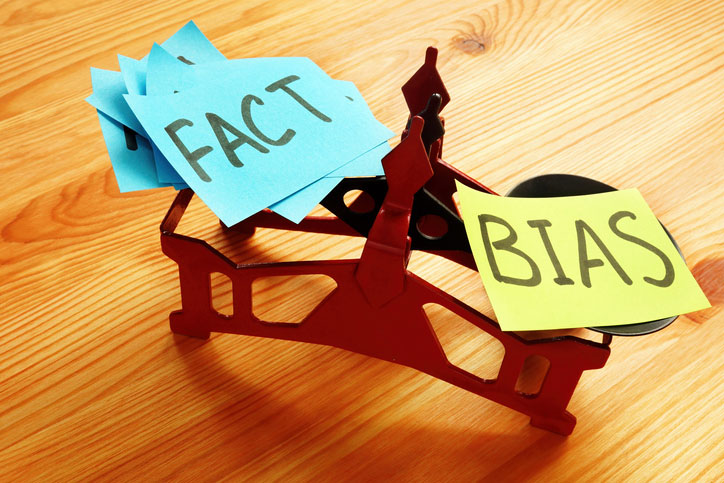
“Atticus told me to delete the adjectives and I’d have the facts.” ~ To Kill a Mockingbird , Harper Lee
The purpose of informative writing is to share information without any opinion or bias. In informative writing, there’s no room for your personal insights, feelings, and attitudes about the subject. The task is clear: educate the reader by conveying factually accurate and relevant information.
It may be presented in the form of an essay, an article, a textbook, a biography, a nonfiction book, how-to guide, a report, and more.
Also called explanatory or expository writing, informative writing comes down to writing about the facts, for the facts, with only the facts in mind.

Here’s what you’ll want to keep in mind as you craft informative pieces:
Informative writing:
- Provides facts and details about a topic using examples and evidence from research
- Educates the reader
- Reports new or interesting findings
- Seeks to improve the reader’s understanding about a topic
Informative writing does not :
- Seek to change the reader’s opinion
- Persuade the reader
- Present an argument
What Is the Purpose of Informative Writing?
Informative writing can accomplish one or more goals:
Describe Something or Share Information
Informative writing may provide a detailed description of something – a person, an event, a thing, a place. “What to do at Yellowstone National Park,” “An examination of Post-WWII Japan,” or “A look at the lifecycle of a Monarch butterfly” – these are all examples of using informative writing to describe a place, thing, or event.
Analyze Cause and Effect
You can use informative writing to describe the effect of something or the how and the why behind things that take place. When addressing the why piece while establishing cause and effect, it’s easy to slip into persuasive or argumentative writing. So it’s important that in your description of cause and effect, you focus on providing factual information that reveals a connection between two factors, not an interpretation based on anything outside of the facts at hand. “How does stress impact your health?” and “What changes did the Civil Rights Movement bring about?” both provide an opportunity to explore cause and effect, and both also present a real challenge when it comes to putting feelings aside to tell the story.
Compare and Contrast
Informative writing is often used to compare similarities or differences between two things. While comparing and contrasting can easily become argumentative (“Why premium gas is better for your car than standard unleaded gas”), it can also be structured in an informative, unbiased fashion (“Comparing the difference between premium gas and standard unleaded gas”).
Explain a Process
“How to change your car’s oil” or “How the ceiling of the Sistine Chapel was pained” are a couple of wildly different examples of how informative writing can provide readers with an in-depth description of a process. How-to guides and step-by-step tutorials are good examples of explaining a process.
Provide an Answer or Solution to a Problem
With this type of write-up, you identify a problem and then its solution. You can highlight one solution to the problem without showing a bias or preference, or you can provide several solutions to the problem at hand. Informative writing in this context provides one or more solutions to questions concerning practical matters like “How do I save money on my heating bill?” or “How do I find the best mortgage rate?”
Answer Why or How
Informative writing can detail how things work or why things happen using clear, unbiased, informative language. For example, “Why does the presidential election in the U.S. rely on using the Electoral College?” and “How does an internal combustion engine work?” both seek to answer a question.
The Best Way to Structure a Piece of Informative Writing

While this type of writing lends itself to a more formal presentation, you can keep the read interesting and engaging by switching up sentence structure and using a variety of bullet points, headings, and subheadings. Keep the flowery language at bay and watch your use of adjectives and adverbs because they can often take an informative piece or an expository or argumentative one.
Informative writing is best organized by providing:
- A strong, opening paragraph that introduces the topic to be discussed
- Supporting paragraphs that include topic sentences, followed by supporting evidence
- A concluding paragraph that provides a summary of key points and evidence
Because informative writing is all about sharing detailed information and facts, it’s a good practice to keep each supporting paragraph organized and focused on just one point, detail, or aspect. It’s also important to present the information in a clear, organized manner that’s accessible to readers unfamiliar with the topic.
Veracity is King in Informative Writing

Citing credible sources helps give informative writing its own credibility. Without source citations, your informative writing piece won’t come across as a reliable, trustworthy read.
Don’t guess, don’t assume, and don’t take something you’ve heard as fact. Verify it, cite it, and use reliable sources.
Your best bet? Government sites (ending in .gov), academic sites (ending in .edu), scholarly journals, and trusted new sites.
- Services Advisory SEO Only Content Only SEO + Content Video
- Free Training
All You Need to Know About Informational Writing
In this article
Are you struggling to write a proper informational article?
You’re certainly not the only one. Many writers find it challenging to follow the guidelines of informational writing and hit the right tone.
This article will teach you precisely what an informational article is and how to write an excellent one without any difficulties.
Disclosure: These reviews are reader-supported. We might earn a small commission if you purchase something through our site. Learn more
Make Writing Fun Again
Set and forget your writing conventions by running Grammarly in the background. Save 20% with our exclusive link .
Grammarly Premium Walkthrough Video
Grammarly Best All-Around
- Only supports English
- Expensive without our link
What Is Informational Writing?
Informational writing is a type of writing with the primary aim of informing a reader about an event, person, etc.
It’s based on facts and doesn’t involve fiction. It’s typically focused on providing information about social events or the natural world. However, articles that tell a story or make an argument are also a type of informational writing.
What Types of Writing Feature Informational Writing?
The fact of the matter is that informational writing covers a very broad range of writing types. After all, as mentioned above, information writing is nothing more than providing readers with real and true information in a precise, concise, and easy to grasp manner. There are various writing pieces that involve this.
You might be writing an informative text for an online blog, an informative essay for academic purpose , an informational narrative for a newspaper column, or you might be creating a lesson to teach to students.
Informational writing is a cornerstone of nonfiction writing, and it usually always involves a coherent thesis statement. Expository pieces, such as something a journalist or whistleblower might write, is another great example.
Grammarly’s Tone Detection feature can help you tell the difference between the two.
Why Does Informational Writing Matter?
The news is a typical example of informational articles. People need it to be in the know about world affairs.
Therefore, informational articles are one of the most critical types of written content, whether it’s online or in print. Did you know that in 2018, Sunday newspaper circulation in the U.S. was 30.8 million? Although many opt for digital media, this number is still high.
Examples of Informational Writing
Newspaper articles are the most common examples of informational writing. However, not all newspaper articles are the same. There are several different structures a writer can use. Here are three examples that you can load up into your favorite writing app : a cause/effect article, a description, a process/sequence article.
Cause/Effect article
When describing an event, many writers use this structure. Sometimes it’s necessary not only to provide the reader with facts but also to explain why something happened.
Depending on the author’s topic and personal preferences, these articles sometimes present causes first and then tackle the consequences later. In other cases, they start with effects and go back to show the causes of an event.
How to recognize this type of text? The time doesn’t pass between the cause and the effect. You can also find some of the following signal words: cause, effect, because, consequently, due to, as a result, etc.

Description
As you can guess from the name, this type of informational article’s goal is to describe people, places, objects, or events.
What’s interesting about this type of writing is that writers use all of the five senses in their descriptions. The use of plenty of adjectives and adverbs is also typical for descriptive informational writing. These articles are excellent for broadening your vocabulary and practicing the use of different literary devices, such as metaphor or hyperbole.
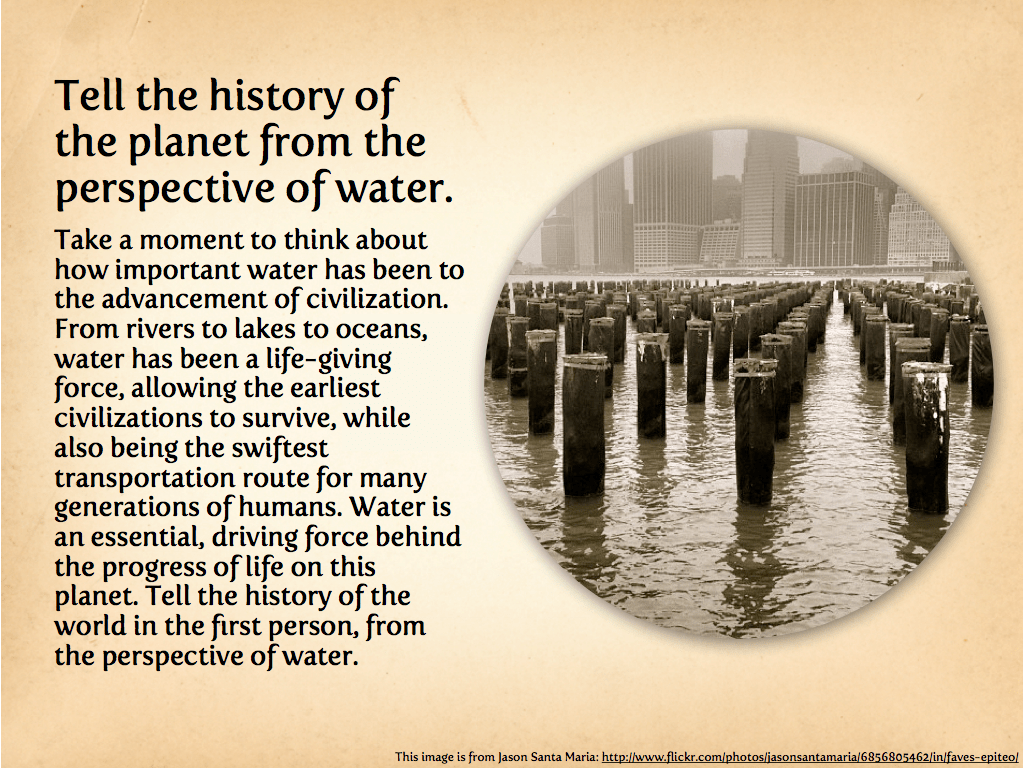
Process or sequence articles
This type of informative article is widespread on the web. It provides the reader with information on how to do something. There are plenty of step-by-step tutorials that are excellent examples of process writing.
For example, if you want to know how to install a particular app on your phone, you’ll find the answer in a sequence article. Recipes are also typical sequence informational articles. Many of these texts have headings that start with “How to.”

Informational Writing Use Cases
Here’s what these described examples look like in practice.
1. This article is an example of cause/effect informational writing. The article explains why some people get sick all the time, while others stay in good health . There’s no chronological order here. The main focus is on the explanation of the reasons why something happens and the effects they cause.
There are plenty of signal words that are also evidence of this being a cause/effect article: the word ‘’because’’ appears four times, the word “cause” appears six times, while “effect” appears seven times in the whole text.

( Image Source )
The article explains why some people get sick all the time, while others stay in good health. There’s no chronological order here. The main focus is on the explanation of the reasons why something happens and the effects they cause.
2. As we already said, people descriptions are a type of informational writing. Especially when we’re talking about biographies , there’s plenty of new information you can get while reading a description of a person’s life from early childhood until their death.
Stephen Hawking’s biography is an excellent example of a descriptive informational article. It gives us a brief introduction to who this scientist was and then describes his life from birth, including his achievements and published work.

3. How-to articles are very popular online, and they’re a type of process informational writing. These give the reader information but in the form of steps. That’s why these articles are also called sequence writing.
As we mentioned, recipes belong to this category as they describe a process step-by-step. For instance, the recipe below lists all the necessary ingredients for making lasagna. It then breaks down the process into four steps.

How to Write an Informational Article: A Step-by-Step Walkthrough
This section will give you a quick step-by-step guide on how to write an informational article on your own.
- Pick a topic. Choose something you’re already knowledgeable about.
- Pick the type of informative article you’d like to write.
- Do thorough research. Find reliable resources, such as official websites of different institutions, to ensure all the facts you’re going to use in the article are accurate.
- Make sure your article has a clear structure: introduction, body, conclusion.
- Write short, concise sentences. Break long paragraphs into smaller ones, so your article is readable online.
- Don’t forget to use the necessary signal words.
- Only provide relevant information related to your topic. When proofreading, delete anything that may seem redundant.
- Proofread your article, or better yet, use a tool to check the grammar, spelling, and style of your informational writing. Also, make sure your piece is unique, and you’ve listed all the sources.
Informational Writing FAQs
How do you start informational writing.
Depending on your topic, there are several interesting ways to start an informational text. For example, you can start with a question – Did you know…? or: Have you ever…? If you’re writing about a serious topic, you could start with a simple definition.
What are other informational text structures?
In this article, we’ve mentioned three of them – cause/effect, description, and sequence. The other two types of informational writing structures are compare/contrast and problem/solution. The compare/contrast article described two items, events, etc. and lists their similarities and differences. A problem/solution article is focused on defining a problem and offering a solution for it.
What is informational business writing?
It’s a particular type of written communication that serves as a reference for a business’s specific aspects. Different business documents belong to this category, but the nature of this content isn’t persuasive. Informational business writing doesn’t need to prompt the reader to take action, but it does need to contain a lot of background information for the readers to take into account.
How do you write a promotional article?
In some aspects, informational and promotional articles are similar. But promotional writing has sales as the primary goal. In promotional writing, you’ll find sales pitches, different persuasive tactics, and manipulations. Informational articles don’t contain these features. Their sole focus is to provide well-researched information and educate the reader.
Keep Your Readers Up-to-Date
Informational writing is an essential part of all writing published on the web. Almost everyone reads the news, and we wouldn’t know what’s going on in the world without such informative articles.
Other than newspaper articles, there are biographies, tutorials, and other articles that provide valuable information for the reader.
Hopefully, this walkthrough has helped you understand what informational writing is and where you can apply it in your business.
Whatever article type you opt for, make sure you only use trustworthy resources to check the facts. It will help you establish yourself as an authority in the field you choose to write about.
Remember that no matter the exact type of writing you are doing, an information writing piece needs to be accurate, well researched, and to the point. This is stuff that second graders learn, so if you don’t have this on lockdown yet, you might want to take a writing workshop to brush up on your skills.
Get long-term ROI.
- HOW TO GET STUDENTS WRITING IN 5 MINUTES OR LESS

Informational Text Structures
Jan 30, 2020
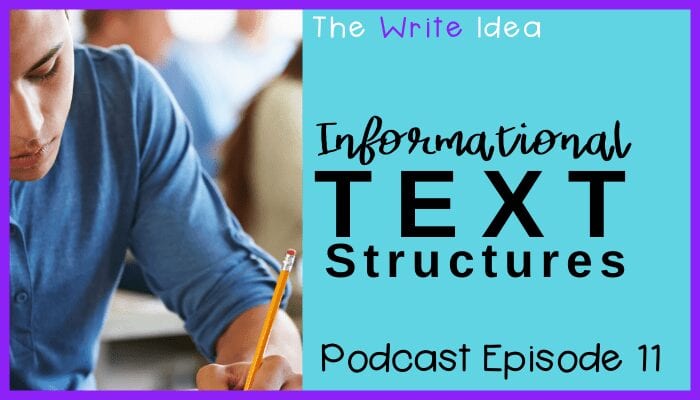
Informational text structures are the organizational patterns all writers must learn. Most people read and write for informational purposes, so it’s imperative that we teach our students these building blocks of writing.
Before we get started though, I want to talk about the differences between text features and text structures. Students often confuse these vital elements of a text. So, I use this analogy: writing an informational text is a lot like building a house.

4. Graphic organizers serve as both tools for analysis and planning writing
A graphic organizer will serve as both a tool for analysis as well as a tool for writing.
After reading, students analyze the text by filling out the graphic organizer and discuss in small groups why they wrote information in certain places. They highlight or underline the transition words they find.
Following this, students use the same graphic organizer to create their own descriptive paragraph about a chosen topic. We practice this a few more times and use a rubric to evaluate their descriptions . Then, we move on to the next text structure.
5. Assign a summative essay or project.
Once I’ve taught all of these structures, students use the graphic organizers to gather evidence for an essay or project. When we start reading longer informational texts, I also point out to students (or allow them to discover) that most texts are made up of several different text structures.
Also, if I haven’t taught introductions and conclusions, then I teach how to write those. Students then use all 5 of the graphic organizers to gather information and decide which they will use for their project.
Broad themes I’ve used to teach informational text structures
Here are some broad themes, I’ve used for projects, and or teaching the organizational structures:
- 6th grade endangered animals
- 7th grade Middle Ages or Child Labor
- 8th grade Civil Rights Era or the Holocaust
- TedX Talks where students choose a topic themselves and present it to the class (in small groups or in front of the class – their choice)
These themes were based on the curriculum I taught at the time for Collections Grade 6 . For example, our 6th grade textbook contains a unit on animal intelligence and another section that argues for and against zoos . I used these as the reading materials for introducing the text structures. Then, I assigned the endangered animals project at the end of the unit.
6. Follow up with argumentative writing
I teach argumentative writing after expository because now students have had the opportunity to learn logos and ethos from learning about text structures. Now, all I have to do is teach the pathos part of writing an argument. I never learned ethos, pathos and logos in school. So, when I Googled methods of persuasion, I discovered this is how teachers teach argument. They teach logos, ethos, pathos.
Logos is the argument’s organizational pattern, while ethos gives the argument credibility from citing credible sources. Pathos is the persuasive/opinion part of the argument.

Informational Text Structures Writing Paragraphs Resources
Informational text structure resources for CCSS RI.6.5, 7.5, and 8.5 are now available in my TPT store. In each informational text structure resource, you will find:
Included in these resources, you’ll find the proven strategies I’ve used over and over again in my classroom:
Google SlidesTM compatible link to Google file of worksheets that can be used again and again with different informational texts along with a Printable activities PDF, which contain:
- Poster for Reading Informational Skill
- Lesson Plan for how to implement these resources
- Learning Scale/Rubric
- Reading Informational Text Vocabulary activity and concept notes with KEYS
- Graphic organizer that analyzes the informational text with this standard
- Paragraph Frame for the writing about the informational text for this standard
- Sentence Stems for Written Responses for this standard
These resources help you scaffold your students with classroom-proven strategies through the process of writing informative paragraphs that can be later grouped together into essays.
1. Read any selected informational text.
2. Introduce the rubric and academic vocabulary
3. Students fill out the graphic organizer, and then they can either use the paragraph frames or the sentence stems as needed for scaffolded support.
4. Conference with students about their progress as they continue to practice writing for this standard.
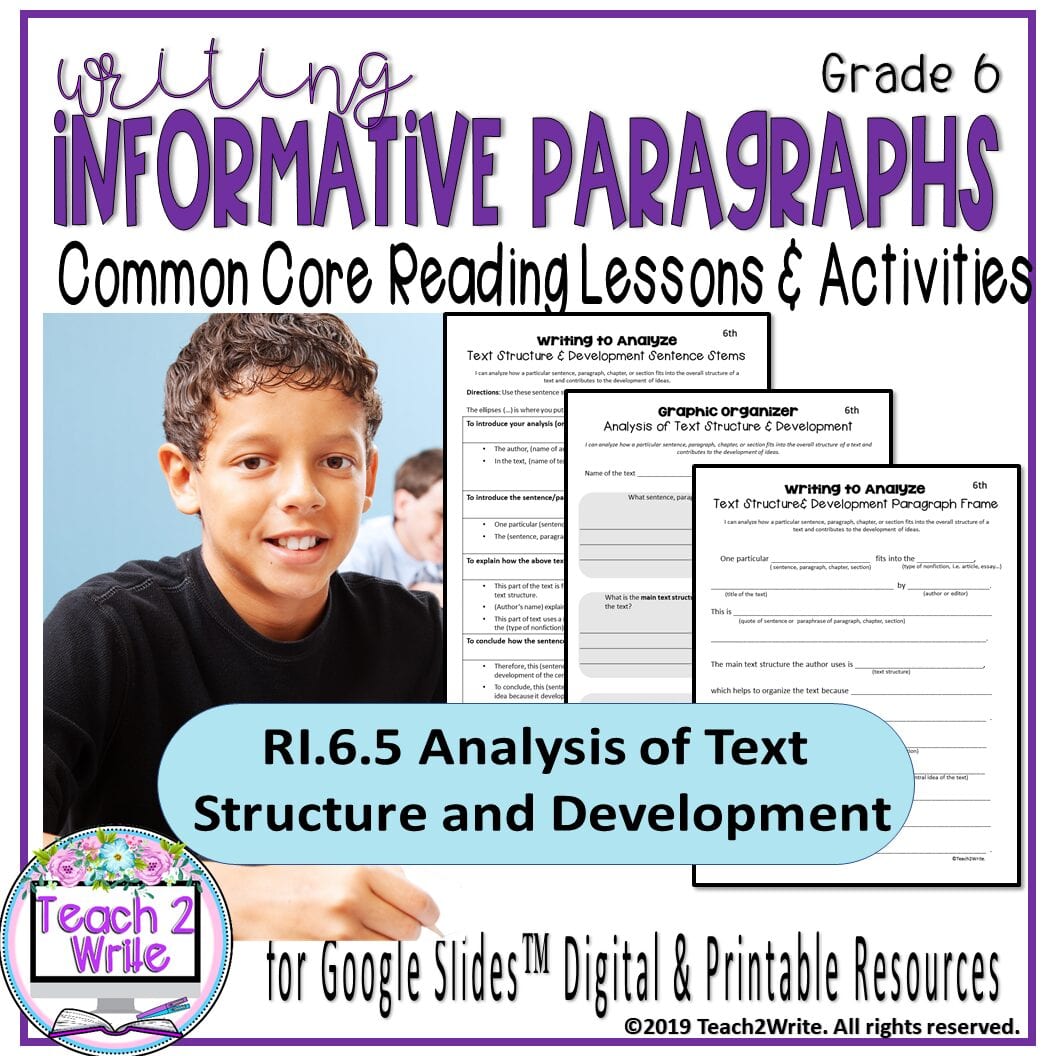
5 Informational Text Lesson Plans Students and Teachers Love
Teach Informational Text Writing like a boss in Just One Week
Bringing your student from zero to hero in a single week is a BIG ask! Especially when we consider the school week only has five days instead of the seven allotted to a calendar week.
In this article, we’ll explore how you can introduce your students to informational texts before guiding them through a series of steps and lesson plans to see them produce their reports by the end of the school week.
BE SURE TO READ OUR COMPLETE GUIDE TO WRITING AN INFORMATION REPORT WRITING HERE FIRST
What Is an Informational Text?
Before we can do that, we need to precisely understand what an information report is.
Informational Texts, also known as Information reports and Informative Writing, are nonfiction texts written to inform the reader about a specific theme or topic. They provide the reader with factual details and descriptions but avoid expressing the writer’s personal opinion on the subject.
We can find informational texts in many places, including encyclopedias, research reports, books on animals, and in history, geography, and science textbooks.
You will frequently encounter them in social studies and nonfiction subject areas in the classroom.
A COMPLETE TEACHING UNIT ON WRITING INFORMATION REPORTS
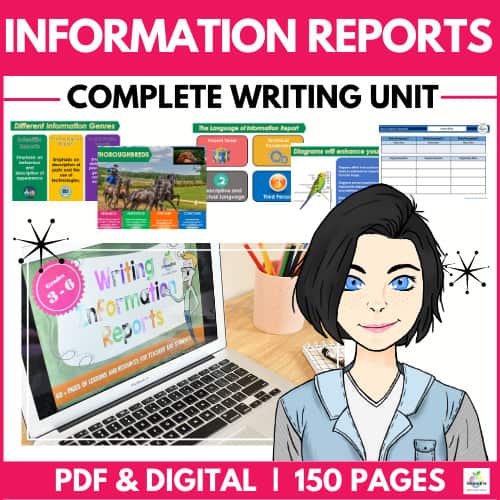
Get an entire unit on INFORMATIONAL TEXTS with no prep required. The editable DIGITAL & PRINT bundle offers a proven model based on research skills, writing strategies, and engaging content with 96 PAGES of material.
How to Master Informational Text Writing in a Single Week
The best way to master anything is to do it. Students should be encouraged to see mistakes as opportunities for learning rather than failures.
This article will outline a path from introducing this fun text type on a Monday to the students producing their information report by Friday. Getting stuck in and having a go is the key to students gaining their black belts in information report writing .
Let’s get started!
Lesson Plan 1: Introduce the Text Structure
First, you’ll need to be sure your students gain a firm grasp of the genre’s defining features. Luckily, informational texts possess a text structure commonly found in most reading schemes.
For your opening activity, gather up a collection of information reports on any theme or topic. Animals, history, people, sport, cities – it’s not essential what the subjects of these books are, as long as they are information reports.
Now, organize your students into smaller working groups of around 4 to 5 students and give them a selection of books written in the information report style.
Give the students about 10 minutes to review the books and compile a list of their similarities and differences.
When they’ve finished, ask them to share some of their answers with the whole class. You can help draw out the students’ observations by asking open-ended questions.
Explain to the students that the books they have been exploring are information reports, and they’re designed to inform the reader about specific topics in a factual way.
Inform the students that they will learn about how information texts work before producing one of their own by the end of the week. To do this, they’ll first have to precisely identify the structure and features of an information report.
Instruct students to work together to reverse engineer a list of criteria for information reports divided under the two headings Structure and Features .
When students have finished, have them share their ideas as a whole class.
As a shared writing activity, complete a master Information Reports Checklist detailing the essential criteria of information reports. It should look something like this:
Informational Text Checklist
- Introduction : defines the topic
- Subheadings : gives a logical order to the information
- Body Paragraphs : provides detail on the subject and further organize information.
- Images support the text through labelled diagrams, illustrations, etc.
- Tense : uses timeless present tense
- Perspective : uses 3rd person perspective
- Definition : provides definitions of uncommon language
- Language : speaks in generalizations
- Language : uses technical, subject-specific terms and vocabulary
- Language : describes using adjectives and lots of detail
- Language: compares and contrasts to give context to the subject
Once you’ve completed the master checklist on the whiteboard, give the students some time to use it against the information report texts they’ve been provided with.
Can they select one as their best example of an information report?
Students can then briefly present their choice explaining how it fulfills the criteria for information texts.
At the end of this session, have your students copy down the checklist into their books or, better still, type up and print off a copy. This checklist will prove helpful later on in the week.
Lesson Plan 2: Research
In the second session, it’s time for your students to gather the necessary information to produce a well-written report.
First, students will need to choose a topic to write about. You can assign a subject for the class or individual students or allow students to choose their topics.
The advantage of assigning a single topic (or offering a limited choice) to the class is that it will be much easier to assess the completed work.
However, allowing students to choose their topic can help ensure they are more engaged in the writing process. What you decide about topic selection will depend on several factors, including age, ability, and number of students.
Once suitable topics have been selected, it’s time for your students to begin the research process.
The aim here is to gather enough relevant information, facts, and data to fuel the writing process to completion.
While the school or class library will be a useful resource, the Internet will most likely be the primary resource tool your students will use.
While the Internet is undoubtedly a fantastic tool for research, students are often unskilled at searching and sorting the most relevant material to help them write.
To ensure they make the most of their research time, ensure your students know how to perform targeted keyword searches. One effective way to do this is by making use of Boolean operators .
Boolean operators are commands that help students combine words and phrases that narrow the results returned when they use the search function.
Not all Boolean operators work on every search engine. In the table below, you’ll find some of the most common operators that work with Google Search.
Standard Boolean Operators for Search Engines
(Limits Results)
Students should use “AND” to combine terms and return only information where both terms occur.
For example, “mouse AND rat” will find only results where both keywords occur.
(One term or another)
The “OR” operator allows students to search for one term or another.
For example, searching for “mouse OR rat” will return results that contain either of these terms.
(Exclude a term from the search)
The “-” operator excludes a term from the results.
For example, “mouse -computer” will return only results in which “mouse” appears, and “computer” does not.
(Search for exact phrase)
Quotation marks allow the student to search for words or phrases exactly as typed.
For example, placing quotation marks around the words “mouse’s diet” will only return results containing those two words in that exact order.
Once students have gathered enough information to complete their reports, it’s time to whip it into a usable shape. And that’s precisely what Day 3 is all about…
Lesson Plan 3: Plan & Organize
Taking the time to organize the information they have gathered and adequately plan their writing ahead of time goes a long way to ensuring students make the most of their writing time.
There is no equivalent of a lucky punch in writing. A well-structured text is the result of good planning and organization.
Make sure your students have a strong understanding of the underlying structure of a well-written information report. Some key elements to reinforce include:
A Table of Contents
While a table of contents might only be required for longer texts, it’s useful for your students to understand how they work. As longer texts will be broken down into distinct sections, these can be listed with their corresponding page numbers to help readers to find specific information.
Though the Table of Contents comes at the front of the text, they are usually compiled at the end when it’s easiest to see where each section falls.
Introduction The purpose of the introduction to an information report is similar to its role in other nonfiction texts. That is, it orients the reader to the subject of the text.
Students will want their information report to be engaging and to seize the readers’ attention from the outset. One way to achieve this is by opening the text with a fascinating fact about the topic.
Body Paragraphs
A comprehensive information report’s body or ‘meat’ will require subheadings to help students organize their texts.
Often, each paragraph or small group of paragraphs will have its subheading, and these subheadings will provide the entries for the table of contents.
Each paragraph (or collection of paragraphs under a single subheading) will focus on a specific aspect of the text’s subject.
For example, suppose the text is about robins, the red-breasted garden bird. In this case, the paragraphs might be grouped under subheadings such as Key Information , What They Eat , Measurements , and Identifying Features .
Conclusion:
The conclusion is often used in an information report to summarize the topic. It can also point the reader toward further resources where they can learn more about the subject.
For online information texts, this may include supplementary hyperlinks to other pages on the website or outbound links to other websites. For printed texts, the conclusion may suggest further options for the reader.
At the end of some information reports, sometimes a glossary will help readers understand any technical vocabulary used in the text.
These are the main sections the students will need to plan for. Graphic organizers containing these or similar elements are an excellent way to help students organize their ideas and information before the writing in earnest begins.
Lesson Plan 4: Write
With a clear understanding of the genre’s structure and features, the topic chosen, and the research gathered and organized into a plan, it’s finally time for the students to begin writing their information report.
‘Write’ is a verb, an action. Students must understand the importance of forward momentum here.
Sometimes the fear of making mistakes can cause a kind of ‘analysis paralysis’ in our students. It’s critical at this point to help them to understand that writing is a many-stage process.
The important thing now is for the student to write their ideas down on paper. Allotting the students a specific amount of time to complete their writing can effectively focus their minds on the task. Be sure to allocate time suited to the student’s age and general ability.
By this stage, students will have completed adequate planning and preparation to fuel a complete draft of their information report by the end of the session.
Of course, some further tweaking will still be required to get that draft up to scratch – and that’s what the final session is all about.
Lesson Plan 5: Edit and Proofread
It’s time to take the rough and ready draft to polished perfection in the week’s final session. This is where the checklists produced in the first session come into play.
Sometimes students find it difficult to identify errors in their work, even with a checklist to work from. Due to this, peer assessment is a good starting point for the editing process.
To do this, organize the students into pairs to assess each other’s work against the checklist. Students can give feedback to each other before they move on to the next stage of the editing process.
Students themselves then decide on the final changes to make to their draft based on their partner’s feedback and their reading of the text.
When they’ve satisfactorily edited their text for structure and features, they’ll need to perform a final close reading for spelling and punctuation.
Report Back Monday Morning!
You’ll now have a nice fresh pile of papers to take home just in time for the weekend! But don’t worry, you won’t be the only one swamped with information reports on a Sunday afternoon.
To get to grips with this text type within a week will require students to make the most of the weekend to consolidate their understanding of the genre.
An easy and effective way to do this is to assign your students some reading for homework. Let them take home an informational text or two to read and, if you’re so minded, you might even ask them to write an information report on it!
OTHER GREAT ARTICLES RELATED TO INFORMATIONAL TEXT WRITING
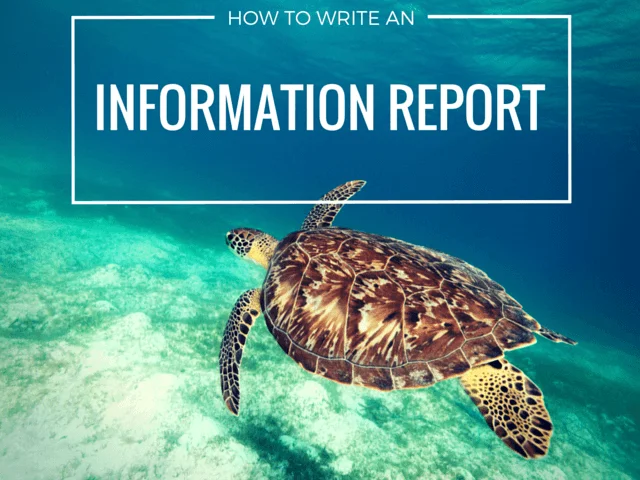
How to Write an Excellent Information Report

5 Essential Informational Text Writing Skills to Master

How to Start an Essay with Strong Hooks and Leads

The Writing Process

How to Write an Article

How to write excellent Procedural Texts
- Share full article
Advertisement
Supported by
Writing curriculum
Informational Writing Unit
We invite both STEM and humanities teachers to consider ways to inject more life into what is perhaps the least-loved genre of academic writing.
By The Learning Network
To learn more about other writing units, visit our writing curriculum overview.
Of the three broad types of writing that the Common Core State Standards emphasize — argument, informational/explanatory and narrative — informational writing may be the category that gets the least love from writing teachers.
Sure, students are writing explanatory pieces all the time, whether in response to questions, in notebooks, in formal papers and on tests. They are also doing this kind of writing across subjects, perhaps in science or history class as much as in English. But as former teachers ourselves, we have found that writing instructors tend to shine the spotlight more brightly on the two sister genres. After all, making a strong argument and telling a compelling story might feel like more interesting tasks than just explaining something clearly and accurately.
But informational writing is the style of writing that dominates The New York Times as well as any other traditional newspaper you might read, and in this unit we hope to show students that it can be every bit as engaging and compelling to read and to write as other genres. Via thousands of articles a month — from front-page reporting on politics to news about athletes in Sports, deep data dives in The Upshot, recipes in Cooking, advice columns in Style and long-form investigative pieces in the magazine — Times journalists find ways to experiment with the genre to intrigue and inform their audiences.
For this unit, however, we are focusing on just one broad area of informational writing — that with a STEM theme. Not only can students find daily models in The Times’s Science, Tech and Health sections, but we have also teamed up with Science News and Science News for Students as a partner for our contest so we can provide an even bigger range of writing examples at different reading levels.
But if you’re a humanities teacher and you’re feeling left out, please know that this contest and our four mentor-text lesson plans are relevant to you, too.
First of all, your students can take on any topic they like under the broad umbrellas of science, technology, engineering, math and health, and we hope they will choose issues and ideas that have real relevance to their lives. But more to the point, the writing skills we want this contest to teach — how to write clearly and engagingly about complex topics — obviously span subject areas. And the specific requirements of the contest — that students have an engaging “hook” as an opening, that they weave in quotations from experts and studies, and that they explain why the topic matters — are elements they will need to master for all kinds of writing tasks.
Below, we provide the core ingredients for our unit, which can be used and adapted whether you are participating in our contest or not.
Start with a writing prompt that will help inspire students to investigate topics that matter to them.
When reporting on STEM-related issues, journalists often start by asking a question about what’s happening in the world around them:
Just how safe is vaping ? Can exercise make us smarter ? How does facial recognition technology work? Why are wildfires becoming infernos? If you touched the moon, what would it feel like ?
Their articles are answers to those questions — or at least attempts to answer.
To begin this unit, we invite students to brainstorm their own questions by responding to our writing prompt: What Questions Do You Have About How the World Works?
The questions they come up with can serve as starting points for the research and writing of their own informational texts for our STEM-related Informational Writing Contest.
Whether they ultimately participate in our contest or not, we hope your students have fun responding to this prompt — and then enjoy reading the questions posed by other students, commenting on them and maybe even hitting that “Recommend” button if they read a response they especially like.
All our prompts are open for comment by students 13 and up, and every comment is read by Times editors before it is approved.
Read mentor texts and try some of the ‘writer’s moves’ we spotlight.
The goal of our mentor-text series is to demystify what good writing looks like and to encourage students to experiment with some of those techniques themselves. We do that by asking both professional science writers and teenage winners of our contests to tell us about their work.
For this unit, we created three mentor-text lesson plans that focus on the individual elements we’re asking student writers to include in their contest submissions. We also invited a science journalist to annotate one of his own articles to take us behind the scenes of his research and writing process and show us how he has woven in those elements.
Here are the mentor texts:
Annotated by the Author: “Tiny Tyrannosaur Hints at How T. Rex Became King”
Hooking the Reader Right From the Start: The Times Trilobites Column
Quoting and Paraphrasing Experts and Research: The Times Tip Column
Explaining Why a Topic Matters: The Times Personal Health Column
And, of course, we always recommend that you read the work of our previous student winners. In 2020, winners wrote about bacteria bombs, fat tongues and microrobots . In 2021 they wrote about star polymers, space origami and singing finches . The video embedded above can give you a glimpse into the process.
What do your students admire about these pieces? What “writer’s moves” might they borrow for their own work?
Enter our STEM Writing Contest.
By the end of the unit, your students will have brainstormed ideas for research, gone behind the scenes of one journalist’s process and practiced key elements of informational writing themselves.
Now we invite them to produce one piece of polished writing that brings it all together.
This contest asks students to choose an issue or question in science, technology, engineering, math or health that interests them, then write a 500-word explanation that will engage and enlighten readers.
All student work will be read by our staff, volunteers from the Times newsroom and Science Times, and/or by educators from around the country. Winners will have their work published on our site and, perhaps, in the print New York Times.
The Third Annual Contest will run from Feb. 2 to March 9, 2022, and we will link to the announcement here when it is live. Until then, check out the Second Annual Contest since we will abide by the same rules and guidelines.
Additional Resources
While the core of our unit is the prompts, mentor texts and contest, we also offer additional resources to inspire and support teachers, including lesson plans and great ideas from our readers around STEM reading and writing.
Our Lessons of the Day that concern STEM-related topics
Reader Idea: ‘Article Days’ and ‘Aha Moments’ Transform Science and Art Classes
Lesson Plan: Teaching Science with the ‘Trilobites’ Column
Register for our on-demand webinar Teaching Informational Writing or watch an edited version below.

Language Comprehension Interventions
- All Literacy Interventions
- Activate Prior Knowledge
- Build Background Knowledge
- High Frequency and Domain Specific Vocabulary
- Defining Words in Context
- Defining Words in Isolation
- Morphology (Prefixes, Suffixes, Roots)
- Sentence Length, Structure, and Type
- Punctuation
- Asking and Answering Factual Questions
- Asking and Answering Inferential Questions
- Asking and Answering Questions Using Mnemonics
- Summarizing Text
- Synthesizing Text (Critical Thinking)
- Narrative Text Structures
- Informational Text Structures
Introduction
Text features, text features interventions, text structures, text structure interventions, response to error: informational text structure, feedback during the lesson, strategies to try after the lesson.
- Instructional Scopes and Sequences
Informational text structure interventions help students learn about how informational texts are organized. These types of interventions teach students how to navigate and comprehend informational texts by applying their knowledge of text features and text structures. When students learn these structures, they can understand the most important parts of the text. This page includes intervention strategies that you can use to support your students' understanding of informational text features and text structure. As you read, consider which of these interventions best aligns with your student's strengths and needs in the whole-learner domains.
Text features are an important part of informational text structure because they help the reader make sense of the main body of text. Text features include: table of contents, glossary, index, charts, captions, headings, diagrams, and tables.When students first begin to read informational text, they often have trouble navigating the text because it looks different from narrative text. There are pictures, labels, diagrams, and captions on the page, and students may have a hard time understanding what to read and when to read it. In order for students to effectively read and understand the main body of text, they need to be explicitly taught about the name and function of each text feature. This page include intervention strategies that you can use to support your students' understanding of informational text features. As you read, consider which of these interventions best aligns with your student's strengths and needs in the whole-learner domains.
Explicit Instruction
To support your students' understanding of informational text features, you should start by explicitly teaching this concept. This sounds like:
Explain the Skill/Concept. Define informational text features, and explain the activity. ( "Informational text features are elements that the author has included to help us understand the main body of text. For example, a heading helps us know what that section will be about. A diagram provides us with a visual so we can see the parts of an object." (Explain other text features.) "Today, we will be learning about how to identify and use these text features and text structures to support our understanding." ) Model Skill with Examples. Think aloud about how you read a text feature. (" When I am reading an informational text, I see elements of the text that are different from what I see in narrative text. I see pictures, captions, diagrams, maps, and other features. I notice that this word is in bold. It's called a heading, and it helps me identify what the next section will be about. ") Model Skill with Non-Examples . Think aloud about reading without using text features. ( "If I skip over using the text features in an informational text, I miss out on some valuable information! This feature is called a diagram, and it shows the different parts of a bat. If I see this text feature and skim right over it, I won't get to learn about the bat's anatomy. ") Practice the Skill. Engage in the activity below to practice the skill with your student, providing feedback as necessary. ( "Now you try to identify the text features and how they support your understanding. ")
Activity A: Text Feature Walk
A Text Feature Walk is done before the students read the main body of the text. This strategy allows students to apply their general knowledge of text features to see how they are used to aid understanding in an informational text:
- In small groups, one student chooses a text feature.
- The student identifies the text structure by name (map, picture, diagram, etc.)
- The student reads the text feature.
- As a group, the students discuss predictions, questions, and connections they have based on the text feature, as well as how it relates to the main idea of the text.
- The process is repeated with all text features.
Text Feature Walk in Action Imagine that you are part of small-group conversation during a Text Feature Walk. You are reading this page about sharks . "Today, we will be doing a Text Feature Walk. In groups of 4, you will take turns reading, identifying, and discussing text features and how they help you understand the text. Remember: don't read the main body of the text yet just focus on the text features! " (Teacher explains five steps.)
A small-group conversation may sound like: Student 1, pointing to caption under the shark with its mouth open: "Fastest Shark." (Student continues to read.) "Fastest shark that's a heading. It tells us what we will read about." All group members: "So, we'll probably read about the shark with the biggest teeth!!!" "No, the heading tells us that we'll read about the fastest shark, not the shark with the biggest teeth!" "I bet we'll read about the Great White Shark!" Next student reads a text feature.
Optional Deep dive: Read this article to gain a better understanding of how to implement a Text Feature Walk in the classroom.
Kelley, M., & Clausen-Grace, N. (2010). Guiding students through expository text with text feature walks. The Reading Teacher, 64 (3), 191-195. Retrieved from http://www.jstor.org.library.relay.edu:2048/stable/40961980
Text structure is how the author organizes the main body of text in an informational text. The five main informational text structures are: sequence, problem/solution, description, compare and contrast, and cause and effect (refer to the Comprehension at a Glance Documen t for a review of these structures). Students must be explicitly taught about the different types of text structures, so that they can identify them as they read. If a student is able to identify the text structure that the author uses, then he will have an understanding of what to look for as he reads. For example, if a student understands that the structure of an informational text is problem/solution, then he knows that these are the two main characteristics he should look for as he reads. This page includes intervention strategies that you can use to support your students' understanding of informational text structures. As you read, consider which of these interventions best aligns with your student's strengths and needs in the whole-learner domains.
Explain the Skill/Concept. Define informational text structure, and explain the activity. ( "An informational text structure is the way that the author has organized the main body of text. There are five main text structures that authors use for informational text, which include sequence, problem/solution, description, compare and contrast, and cause and effect. The author chooses this text structure based on what he wants you to learn about. For example, if the author wants you to learn about how two sharks are similar and different, he would use a compare-and-contrast structure so that we read about one topic first, and then about the other." (Explain other text structures.) "Today, we will be learning about how to identify these text structures to support our understanding." ) Model Skill with Examples. Think aloud about how you identify a text structure. (" Before I read an informational text, I scan the text to see if I can identify the text structure that the author used. I do this because knowing the structure will help me read the text more efficiently. For example, let's look at our shark text. I'm going to think aloud about how I determine the text structure. First, I look at the layout and identify any key words that align with the text structures. I don't see the words cause and effect or compare and contrast. I also don't see that there is a problem. Now, I'm going to use the text features to see if I can identify the structure. When I look at the headings, I see that the author describes a different type of shark in each paragraph, so I think the author used a description structure. Now I know that when I read each paragraph, I will learn details about different types of sharks. ") Model Skill with Non-Examples . Think aloud about reading without using identifying text structure. ( "Watch what happens when I don't identify the text structure when I read. " (Teacher reads page.) " Okay, so I've read the page about sharks. It sounds like there are a lot of kinds of sharks, but I'm not sure what I should do with this information. When I don't identify the text structure, I read without a purpose." ) Practice the Skill. Engage in the activity below to practice the skill with your student, providing feedback as necessary. ( "Now you try to identify the text structures that the author used. ")
Activity B: SQ3R
SQ3R stands for Survey! Question! Read! Recite! Review! and is a reading strategy developed by Robinson (1970). This strategy can be used across texts, but can be particularly effective for informational texts so that students can preview the text features to form hypotheses about the information they are about to read. The five parts of SQ3R are as follows:
- Survey (before class) - Survey the chapter/text to get a sense of how the information is organized. During this time, students should get a general idea of what the text is about, what kind of information the author gives, and how many sub-topics there are
- Question (before class) - Turn each boldfaced heading into a question by using one of the following words: who, what, when, why, or how
- Read (after class) - Read the time, and write the answer to the question posed in Question
- Recite (after class) - Recite the answer, and put it into your own words
- Review (before next class) - Cover the answers, and ask yourself the questions to review important information.
SQ3R in Action Give students a passage of text, and explain that they will be using the SQ3R strategy to preview and read the text. In this case, refer back to the shark text in Activity A. Identify each step of the process (Survey! Question! Read! Recite! Review), model for students, and have students complete the activity. Teacher: "Today, we will be using the SQ3R strategy to read and understand our text. During this process, you will..." (explain 5 steps). Survey - "Watch as I model this strategy. First is S, Survey. I will survey the text to get a sense of how the content is organized. I see that there are lots of pictures and captions under the pictures. There are parts of text at the top and on the side. It looks like the text is broken down into smaller chunks by the headings. The main topic is sharks, but I can see that there are subtopics like fastest shark, largest fish, shark with the largest teeth, and so on. I see that the author is using the informational text structure of description because he is describing different types of sharks. He must be writing to inform the reader about the different species of sharks and what makes the sharks special." Question - "Now on to Q, Question. I'm going to practice turning each boldfaced heading into a question using one of the 5 W words. Let's try the heading Fastest Shark. My question is "What is the fastest shark?" (Teacher continues with all headings.) Read- "Now, R, Read. I will read the text and answer my questions." (Teacher reads aloud.) "My question for this section was "What is the fastest shark? My answer is: 'The fastest shark is the Shortfin Mako, which can swim over 35 mph!" (Teacher continues to answer questions.) Recite- "Now, R. Recite. I will try to put my question and answer into my own words. One of the fastest sharks in the world is called the Shortfin Mako. This shark can swim almost 35 mph!" (Teacher demonstrates with other sections.)
Review - "Finally our last step, R, Review. I'll cover my answers and see if I can remember the important information." (Teacher covers answers.) "What is the fastest shark? Well, it's the Shortfin Mako!"
Activity C: Main Idea & Supporting Details
Main Idea & Supporting Details is a reading strategy that students can use to help them distinguish important details from unimportant details in an informational text. Using this graphic organizer, students first write the main idea, and then find evidence in the text that supports the main idea. When students are just beginning to use this strategy, they can turn the headings into a question (from the Text Feature Walk activity above) and write the question into the main-idea box. Then, they can go back into the text and find three supporting details that answer this question.
Main Idea PDF
Main Idea and supporting details. (n.d.). Copyright at Relay GSE. New York, NY: Relay Graduate School of Education. Main Idea & Supporting Details in Action Imagine your class is reading this text about sharks as you read the script below.
Teacher: "Let's try finding the Main Idea and Supporting Details in our shark text. The heading to this section is 'Fastest Shark.' Let's first turn that into a question: What is the fastest shark? I will write that in my Main Idea box. Now, I want to find two supporting details that answer this question. Ok, I see one here: The Shortfin Mako is the fastest shark, so I'll write that down. I also see that it can swim up to 35 mph, so I'll write that down as well. Let's check: do these two supporting details answer my Main Idea question?" (Reads details.) "Yes."
Note: Activity C is one example of a graphic organizer that supports understanding of text structures. You can find more examples of graphic organizers that support text structure on the Summarizing and Synthesizing page.
Robinson, Francis, Pleasant. (1970). Effective study . New York: Harper & Row. Seminar on Literature for Youth. (2016). Sharks . Retrieved August 25 from http://eduscapes.com/nonfiction/images/sharkg.png.
Think about the following scenario, which takes place after a teacher has explicitly taught about how to identify and use text features, and has given multiple opportunities for practice: Teacher, pointing to a diagram of a bat's anatomy: "What text feature is this, and what information does it give us?" Student: "That's a picture. It helps you know that bats fly."
In such a case, what might you do?
When you are planning your lessons, you should anticipate that your student will make errors throughout. Here are a series of prompts that you can use to respond to errors. Keep in mind that all students are different, and that students might respond better to some types of feedback than others.
If your student struggles to meet your objective, there are various techniques that you might try to adjust the activity so as best to meet your student's needs.
- << Previous: Narrative Text Structures
- Next: Instructional Scopes and Sequences >>
- Last Updated: Jul 26, 2023 6:35 PM
- URL: https://relay.libguides.com/language-comprehension

Top 3 Product Matches

Adventures of Tom Sawyer
Retail Price: $9.95 Our Price: $7.46 or less

Reproducible
Our Price: $19.95

Downloadable PDF File
Our Price: $14.95
- Prestwick House Blog
- Free Library
- Teaching Guides
- Grammar & Writing
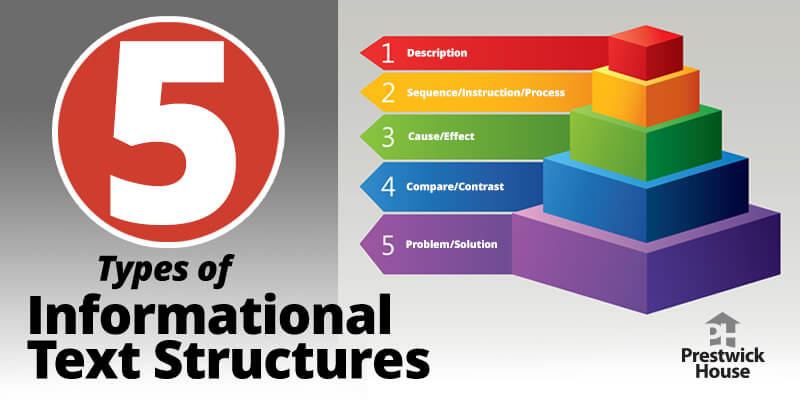
5 Types of Informational Text Structures
- by Derek Spencer
The vast majority of texts are written for one or more of these three purposes:
- To make an argument
- To tell a story
To achieve these purposes, authors use one or more of the following 5 text structures:
- Description
- Sequence/Instruction/Process
- Cause/Effect
- Compare/Contrast
- Problem/Solution
Students must be able to unpack these 5 text structures and study their components in order to fully understand and analyze informational texts, whether they're reading textbooks, news articles, or works of literary nonfiction.
1. Description
This is pretty straightforward. Texts that use this structure simply describe something. With few exceptions, these texts also present plenty of details about what they're describing.
A text using this structure might also:
- Tell you why something is being described
- Tell you why the described topic is important
- Provide examples of the described topic(s)
Descriptive texts are everywhere—in novels, works of literary nonfiction, news articles, science textbooks—which makes sense because the entire point of description is to present information.
2. Sequence/Instruction/Process
This text structure covers a few purposes:
- Sequential instructions (Step 1, Step 2, Step 3; do this, then do that, and finally do this)
- Chronological events (This happened, then this happened, then this happened, etc.)
- Arguments that use evidence to support a claim (presenting evidence from least to most convincing)
When students read or write a text with this structure, order is key. Texts that use this format usually don't present any event or instruction out of order, as doing so would make its directions more difficult to follow.
As a ludicrous example, imagine a cake recipe in which preheating the oven is the last step. It would just be confusing and odd. Poorly written instructions just aren't worth your time.
Here is a non-exhaustive list of words and phrases that indicate a text follows the sequence/instruction/process text structure:
3. Cause/Effect
Cause/Effect text structures explain, well, causes and effects. Sounds pretty simple! But works that use this structure can become complex when an effect has multiple causes (or vice versa).
Students will encounter complex examples of cause-effect when they read historical texts. Many events in history had more than one cause, all related in ways that can be difficult to unpack.
Here is a non-exhaustive list of words and phrases that indicate a text follows the cause/effect text structure:
4. Compare/Contrast
This text structure involves a comparison involving multiple things, revealing how they are similar and how they are different.
Make sure your students know that contrasting two or more things doesn't necessarily mean identifying them as either good or bad. Comparisons simply relay the differences; therefore, one thing could have both positive and negative traits.
Here is a non-exhaustive list of words and phrases that indicate a text follows the compare/contrast text structure:
5. Problem/Solution
This text structure involves two parts:
- The author identifies a problem
- The author details a solution to this problem
Problem/Solution can be a very complex text structure, as it necessitates the use of other structures, too. Clearly, the author needs to describe the problem. The author would likely also explain the causes and effects of the problem in order to argue in favor of their solution. Does implementing the author's solution involve following a series of specific steps? That involves another structure. What if the author wants to mention other potential solutions and then explain why their solution is the best one? Oh, hello there, Compare/Contrast!
What's important here, as it is with any text in which an author marshals an argument, is that the author uses only the information needed to advance the argument or refute counterarguments. When students examine a text that uses the Problem/Solution text structure, they should examine at least two things: the argument as a whole and the individual components of it.
Knowing that aspects of other text structures might appear in the Problem/Solution one will help students examine the argument's individual components. That's why it's essential that students understand and can analyze the other four structures if you want them to be able to examine Problem/Solution effectively.
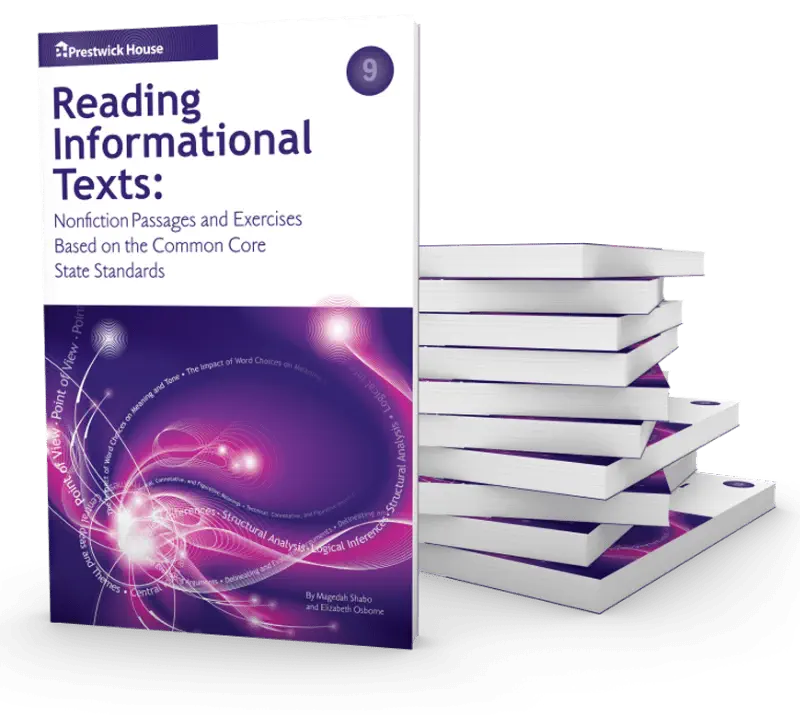
Reading Informational Texts
Looking for a series that makes teaching informational material easier? Try Reading Informational Texts , available for grades 7–12. Each book in this series offers challenging nonfiction passages that align with the rigorous guidelines of the Common Core State Standards.
Newsletter Signup
Information and Products
- Privacy Policy
- Terms of Service
- Popular Searches
- Payment Information
- Grammar & Writing
- More Resources
- Order By Catalog Code
Customer Service
1.800.932.4593
Connect With Us
Copyright 2024 Prestwick House. All Rights Reserved.
- Skip to main content
- Skip to primary sidebar
- Skip to footer
Get the goods. Subscribe to my newsletter! >>
Jen Kimbrell
Educator & Teacher Seller
in Teaching · November 18, 2023
Easy-to-Follow Informational Writing Lesson Plans
You know how you’re always looking for new and exciting ways to teach your students the art of expressing themselves through the written word? Well, I’ve got some great news for you. In this blog post, we’re diving headfirst into creating informational writing lesson plans.
These are not your run-of-the-mill lesson plans; they’re the secret sauce to helping our students become stellar communicators, critical thinkers, and effective writers. So, grab your coffee and learn how to make teaching informational writing a breeze. Let me share my game-changing strategies that will have you and your students loving the process of informative writing.
Pin for Later

Why Informational Writing Matters
Informational writing is a big deal. It’s all about conveying facts, knowledge, and ideas to your readers. Whether you’re explaining a specific topic, describing an event, or reporting on your latest research findings, informational writing plays a crucial role in our everyday lives.
Think about it: when you read a blog post, a news article, or a textbook, you’re engaging with informational text. So, learning how to write effectively in this genre is essential. You’ll not only improve your own writing skills but also become a more informed and empowered reader. So, I would say the informative writing lesson plans might be your greatest writing resource in your teacher toolbox.
Informational Writing vs. Other Types of Writing
Before we dive into the tips, let’s clear up the distinction between informational writing and other types of writing. The three main types of writing taught in schools:
Informational Writing
This type of writing is about presenting facts, data, or information clearly and organized. It’s often used in reports, essays, articles, and nonfiction books.
Narrative Writing
Narrative writing tells a story. It’s used in novels, short stories, and personal narratives. The focus is on characters, plot, and storytelling.
Opinion Writing
In opinion writing, the writer shares their perspective, point of view, or belief on a particular topic. It’s commonly found in editorials, persuasive essays, and blog posts.

The Writing Workshop
The writing workshop is a dynamic way to teach and practice informational writing. In a workshop, students can write, share their work with peers, receive feedback, and revise their writing. It’s a powerful method for honing their writing skills.
Teaching the Writing Process
Another important aspect of the writers’ workshop is understanding the writing process. While not all writing has to go through the writing process, it is important we help students understand that writing consists of several stages, and it’s essential to follow them to create a well-structured and polished piece of writing. Here are the key stages:
1. Prewriting – This is where you brainstorm ideas, select a specific topic, and gather relevant information. You can use graphic organizers, mind maps, or lists to organize your thoughts.
2. Drafting – In this stage, you put your ideas into sentences and paragraphs. Start with a strong topic sentence that introduces your main point.
3. Revising involves reviewing your draft for clarity, coherence, and organization. Check if your writing flows smoothly and if you’ve included all the important information.
4. Editing – In the editing stage, focus on grammar, punctuation, spelling, and sentence structure. Ensure that your writing is free from errors and is easy to understand.
5. Publishing – This is the final stage for preparing your writing for your audience. You can type or write out your final piece neatly, add illustrations or images, and make it presentable.

The Informational Text Structure
Understanding how to structure an informational piece is crucial. The typical structure includes:
1. Introduction – The introduction aims to grab the reader’s attention and provide an overview of your discussion. It’s where you’ll include your topic sentence, clearly stating your main idea.
2. Key Details – The body of your informational piece contains details supporting the topic’s main idea. Each paragraph should focus on a specific aspect of your topic. Start with a topic sentence, provide relevant information and evidence, and conclude the paragraph with a closing sentence.
3. Conclusion – The conclusion should summarize the main points and give the reader a clear understanding of the topic. Restate the main idea without introducing new information.

Using a Graphic Organizers
There are a lot of graphic organizers to help students organize their thinking. I like to keep it consistent and typically use the four-square template. This is the perfect organization for young writers.
A Closer Look at an Informative Writing Unit
To get good informational writing pieces from our students, we must first build background knowledge and vocabulary or teach them how to do it themselves. I like introducing the topic through discussion to find out what students already know about it and have them write it down. Then, use a video, book, or other resource to add to the discussion and see if students’ knowledge was correct or if they had a few misconceptions. Hopefully, this lesson sparks more questions and wonderings about the topic. These questions should help guide the student’s research and the teacher’s mini-lessons.
Learn More About the Topic Through Exploration
Then, take some time to explore the topic. If students have different topics to research, show them how to find resources or provide links and resources depending on their age. Here are some ideas for stations:
- Books/Magazine/Articles
- Computer/Games/Videos
- Photo/Vocabulary
- Listening Station (Books Read Aloud)
- Observation Station (Experiements)
- STREAM Stations (Science, Technology, Reading, Engineering, Art, and Math)

I typically have exit tickets for each station to write what they learned about the topic. These exit tickets come in handy when it’s time to plan their writing.
The Power of the Mini-Lesson
Organizing the research.
Gather students as a whole class and model how to take the information from the stations and organize everything. You can do this in several ways, such as using Post-it notes or a Padlet. Then, take the information and add it to a 4-Square graphic organizer.
Writing an Introduction or Topic Sentence
The introduction is your chance to make a strong first impression. The purpose of the introduction is to let the reader know what the writing is about and to be intrigued and motivated to keep reading. Share strategies for creating compelling introductions, such as starting with a surprising fact, a thought-provoking question, or a powerful anecdote. Explore mentor texts of how authors do this and create an anchor chart of examples.
Anchor charts are an excellent way to represent key concepts and writing strategies visually. They can be used as reference tools in the classroom. Create anchor charts for various aspects of informational writing, including the structure, introduction strategies, and citing sources.
Mentor texts are examples of well-written informational pieces that can serve as models for students. Choose informative writing mentor texts that are engaging, informative, and aligned with the grade level. Analyze these texts with your students to highlight effective writing techniques.

Key Details
Three squares from the graphic organizer are key details about the main idea. Students in 1st and 2nd grade may write one sentence per square, but as they get into 3rd grade, they must provide more facts under each detail. This procedure is to be modeled during the mini-lesson. I like to use the Gradual Release Model. If all students are writing on the same topic, I might model the first square for the students, the second square we do together, and then the 3rd square is done as independent work. It looks as follows:
I do: Teacher models We do: Student and teacher do it together You do: Student does one on their own
Of course, once students get the hang of the structure, students can start writing their details on their own.
Teach Transitional Words
To ensure smooth transitions between paragraphs, use transitional phrases or words like “however,” “in addition,” and “on the other hand.”
Writing a Conclusion
The last square is the concluding statement or paragraph. The purpose of the conclusion is to wrap up the writing. It is basically reiterating the introduction. As with the introduction, use mentor texts and anchor charts to help students explore exemplar models.
Edit and Revise
After drafting your informational piece, take the time to edit and revise. Check for grammar and punctuation errors, and ensure your writing is clear and coherent. You may want to provide a writing checklist to help students stay organized and focused. This checklist can include items like:
- Do you have a topic sentence or paragraph?
- Do you have three key details that support the main idea?
- Read your story out loud to see if it makes sense.
- Cross out words or insert words.
- Circle words that are misspelled.
- Do you have correct punctuation?
- Is the conclusion a concise summary of the main points?
- Seek Feedback and Write the Final Draft
Have students share their writing with you or a peer. Constructive feedback can help improve writing and make it even better. Once students have completed the steps, they may write their final draft and prepare for publishing.
Digital Resources for Informational Writing
Students must publish their work somehow after the entire writing process. In today’s digital age, there are a lot of fun and exciting ways for students to share their writing.
- Book Creator
- Google Slides
- Write About This App
- Scratch, Jr.
Differentiation to Meet Students’ Needs
Every student is unique, and their learning needs may differ. Differentiation is a teaching approach that allows educators to adapt their instruction to meet the specific needs of each student. When teaching informational writing, consider the following strategies for differentiation:
Varied writing topics – Offer a range of writing topics so students can choose a topic that interests them.
Flexible grouping – Students can work in pairs, small groups, or independently, depending on their preferences and needs.
Scaffolded instruction – Provide additional support or scaffolding for students who may require it, such as graphic organizers or sentence starters.
Extension activities – Offer extension activities or projects for students who need more challenge or depth in their learning.

Different Ways to Explore Informational Writing
Informational writing can take many forms. While essays are common, students can explore other formats of informational writing. They include:
- Procedural Writing (How-To Writing)
- Text Features
- Problem/Solution
- Compare and Contrast
Informational writing isn’t confined to a single subject area; it can span various fields of study. Here are some ideas for incorporating informational writing across different subject areas:
Social Studies: Write reports about historical events, famous figures, or cultural traditions.
Science: Explore scientific concepts, conduct experiments, and explain findings in detail.
Mathematics: Explain mathematical concepts, problem-solving strategies, or the history of famous mathematicians.
Done for You Informational Writing Unit Plans
To provide a comprehensive understanding of informational writing, you can develop unit plans that cover various aspects of this type of writing. These unit plans can include a sequence of lessons, suggested reading materials, activities, and assessments. You can align these plans with the Common Core or grade-level standards.

I hope this blog post has given you valuable insights into the world of informational writing. Whether a student or a teacher, these lesson plans and tips can help you master the art of conveying information effectively through writing.
Informational writing is a skill you can use in various aspects of life. It’s a valuable tool for sharing knowledge and ideas, from academic reports to professional documents. So, keep honing your skills, and remember that the best way to become an excellent writer is through meaningful practice and a passion for learning.
With the right guidance and resources, you can develop your informational writing skills and create well-structured, engaging, and informative pieces that captivate your readers. Happy writing!
Reader Interactions
Leave a reply cancel reply.
Your email address will not be published. Required fields are marked *
Save my name, email, and website in this browser for the next time I comment.
You’ve Got Mail!!
Let's keep in touch.

Don't leave yet!
Did you know that I offer teaching freebies every month? Sign up for my newsletter to get access to these resources!

Informational Writing Lessons Made Easy
Informational writing can be simple to teach young students if you follow this outline and your lessons are interactive and motivating.
Features of Informative Writing
If you’re like me and teaching elementary students, the first step in any writing lesson is laying the foundation. That’s why I explicitly teach students the feature of informational writing first.
Students need to know that informational writing:
- Explains a topic
- Provides facts and definitions related to the topic
- Using linking words to connect ideas
- Includes a conclusion
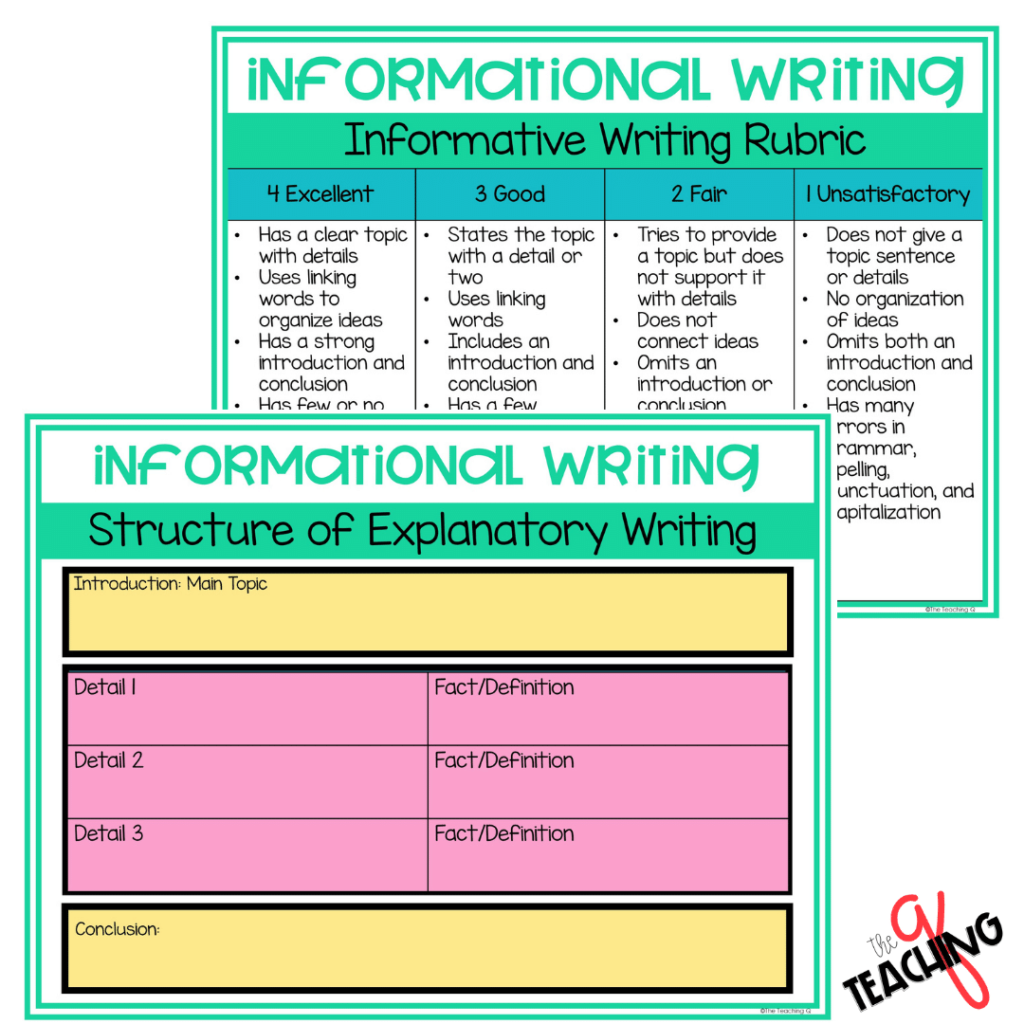
Informational Writing Structure
Students are now ready for the informational graphic organizer. Each feature of the informative writing learned earlier fits nicely in the graphic organizer. (For some reason, students are shocked by this demonstration.)
To take it a step further, hand out the Informational Writing Rubric. Students see that each piece of the graphic organizer is also on the writing rubric during this time.
I like to make a big deal of handing over the “magic” to a beautiful writing score.
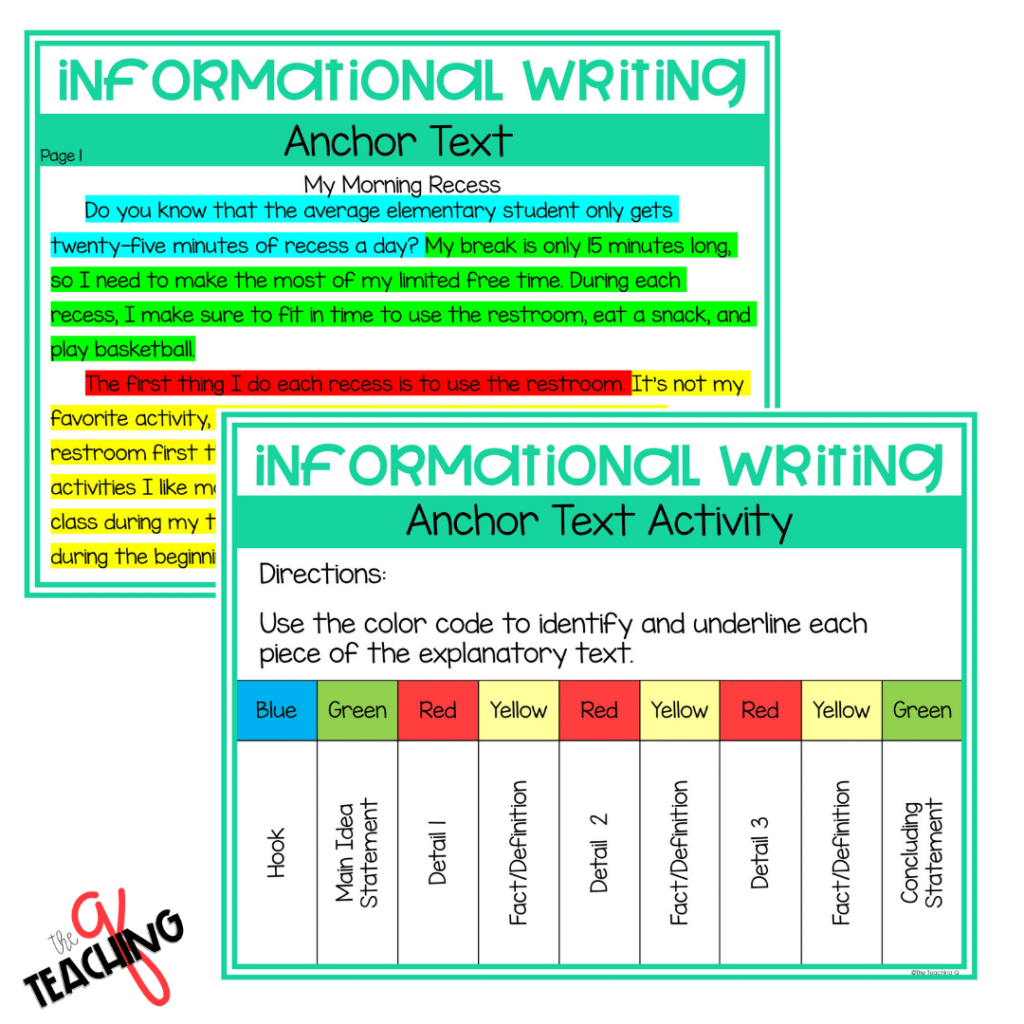
Anchor Text Activity
Now that students are familiar with the structure of informational writing, they are ready for the anchor text. The purpose of the anchor text is to provide a strong example of an essay.
I typically spend an entire writing period with the students, identifying each of the informational writing elements in the anchor text.
I call this activity the Color Code the Text. For the printable version, each student has a copy of the anchor text and using highlighters or crayons to color each element. For the digital version, each student drags the highlighted marks over the text.
If this is my student’s first exposure to the activity, we do the activity together as a whole class.
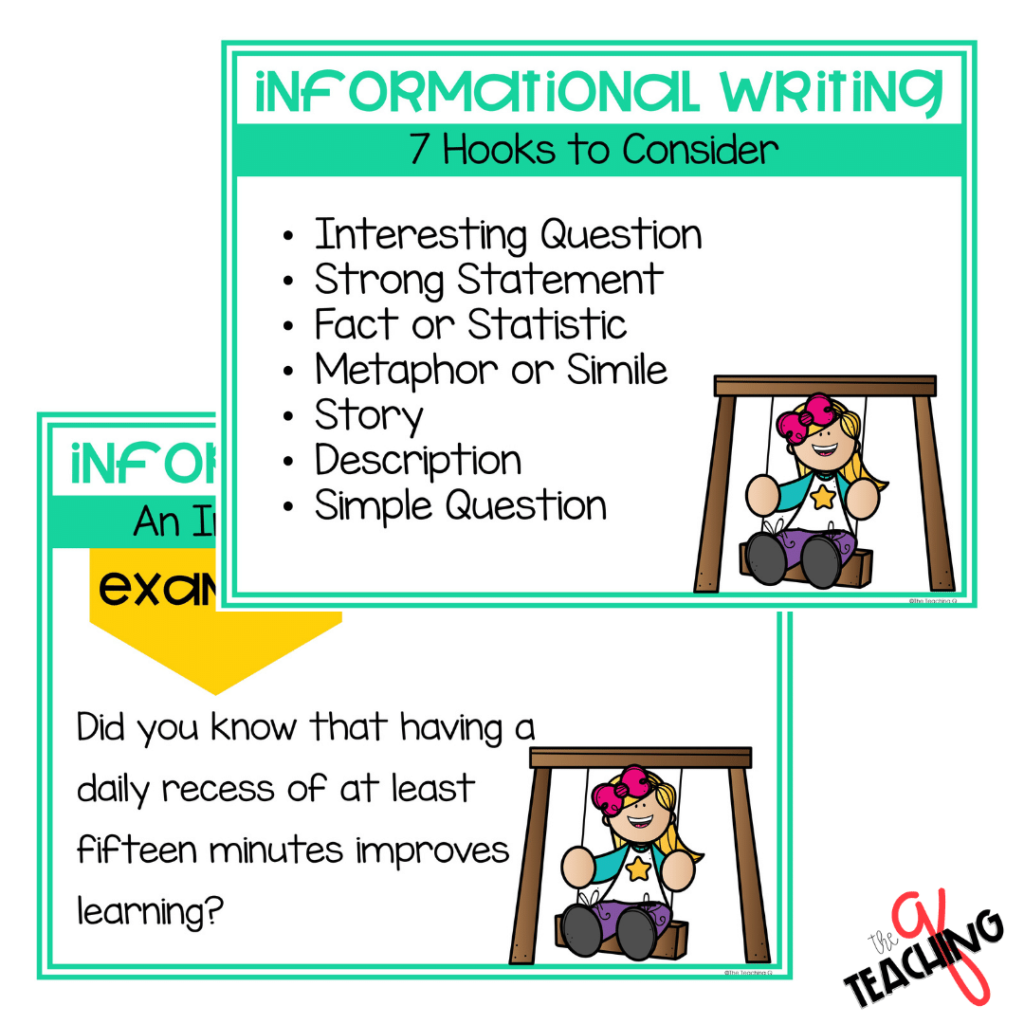
Teaching the Introduction
It’s essential to let young writers know that the purpose of the introduction is to get the reader’s attention and let them know the topic you will be discussing.
For this reason, I teach a mini-lesson on seven types of hooks. Most importantly, this exposes students to samples of each kind of hook before writing their own.
The second mini-lesson to teach students is how to write the main idea statement. We spend a great deal of time practicing how to say the main idea before with write.
Often, students mistakenly elaborate with details within the introduction, so this is an area to stress early. (Make the corrections early before it’s out of hand.)
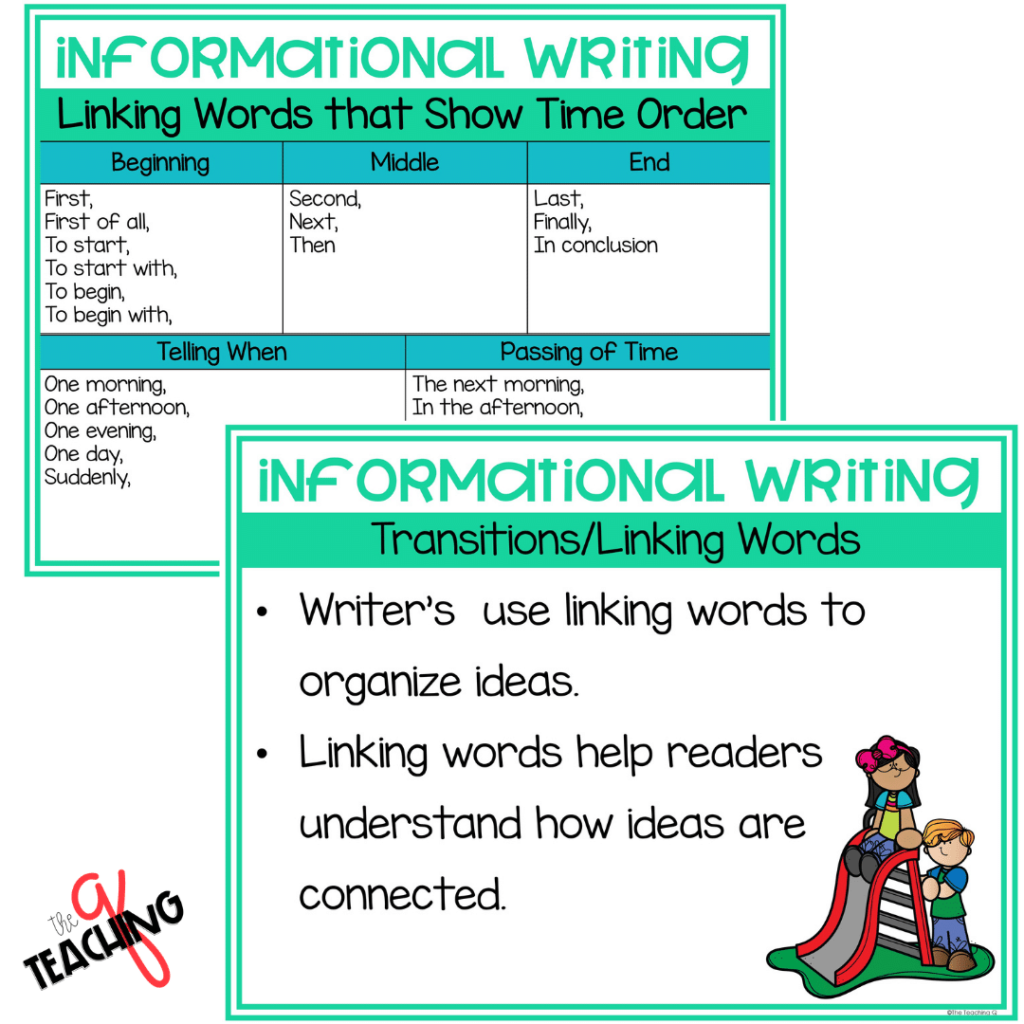
Supporting Detail s
Now your students are ready to elaborate and give all the related facts. But before I let them write, I make sure they’ve had ample practice providing details with task card activities.
Another element of the rubric and structure of informative writing is the use of linking words. I’ve found that a simple list of possible linking words is worth its weight in gold.
Once students have added linking words to their writing, I allow the class time to share their masterpieces. (My students always love to share .
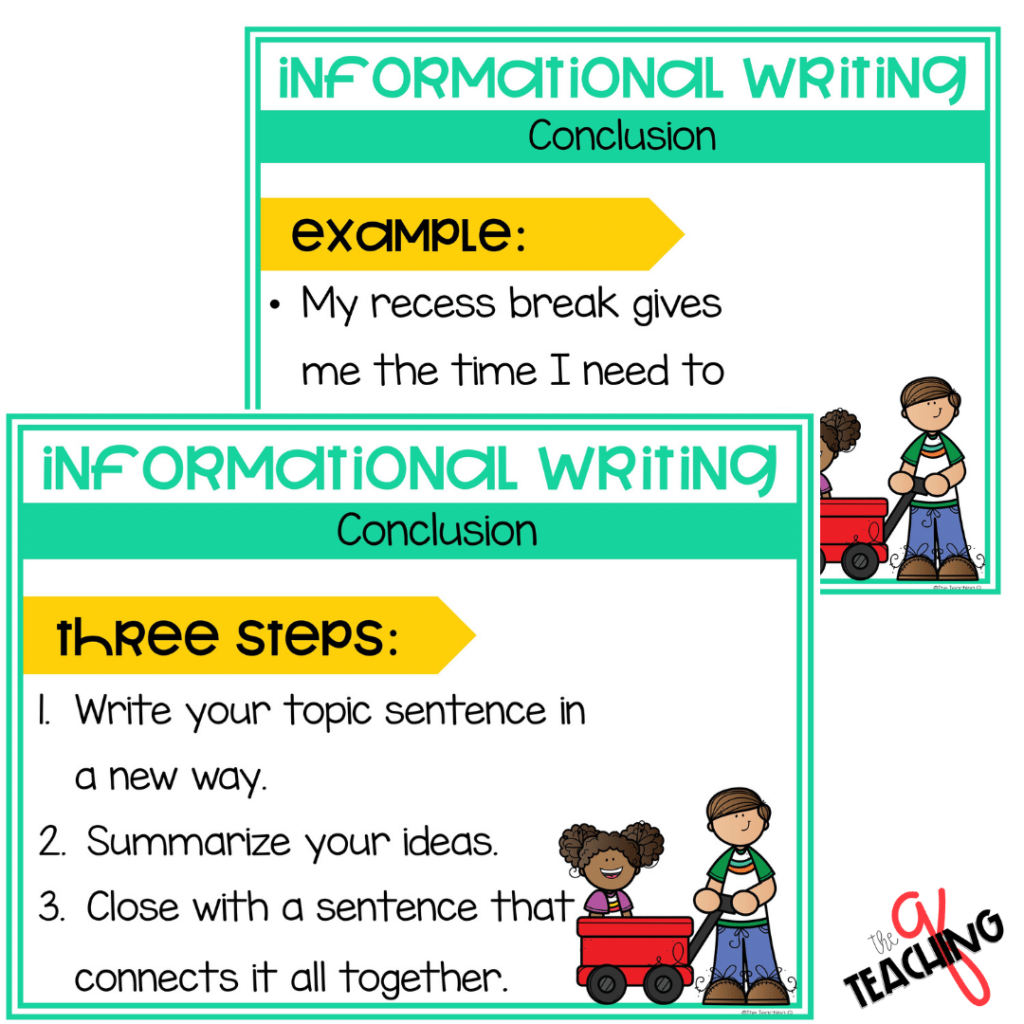
Conclusions in Informational Writing
Finally, we’re at the last few steps of the informational writing process. An enormous beast to conquer is teaching the concluding statement.
I teach students to write conclusions with three simple steps.
- Turn the topic sentence around
- Summarize your ideas/points
- Use a closing sentence to connect the ideas
By following this simple format, students are ready to edit, revise, and publish their writing! (Ta-da!)
If you want the ready-made resources, you can pick them up in my Teachers Pay Teachers Store here .
Below are a few prompts from my Informational Writing Units that you may be interested in purchasing.
- Write about how you spend your time during recess.
- Write about a toy you enjoy play with and share why.
Each of the resources is in a printable and digital form together.
You may also want to read my blog post on 5 Narrative Writing Essentials or Opinion Writing Streamlined in 5 Days .
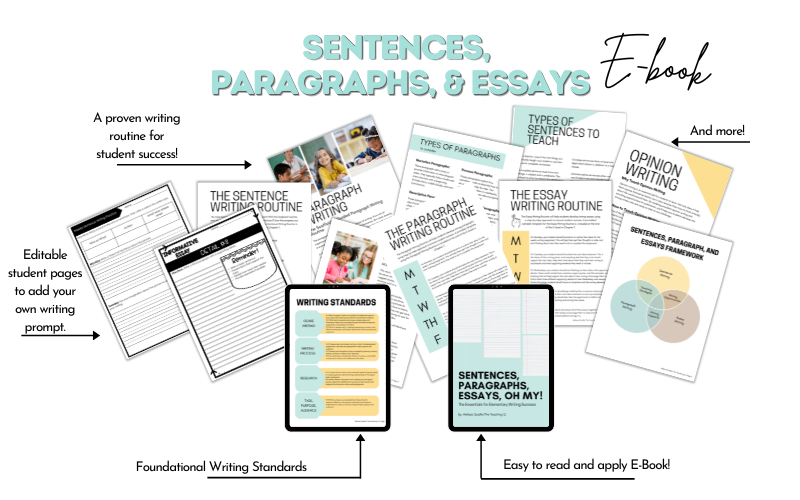
Are your students struggling and making very little progress in writing? Or maybe they’re unmotivated or a reluctant writer? If so, I’ve got your back.
Yes…I…Do!
Let me share my secret sauce when it comes to teaching writing to elementary students.
It’s the Sentences, Paragraphs, and Essays: OH, MY! E-book.
Click this li nk to learn more about how the E-Book can transform your students’ chicken scratch, hap-hazard writing into strong, effective, glorious writing!
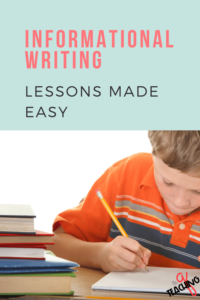
FREE Paragraph Writing Handbook & Lessons
Join the email list and I’ll send you a FREE guide to teaching reluctant writers. Plus, I have a FREE Writing Craft to get you started.

Check Out the New Website Shop!

Novels & Picture Books

Anchor Charts

- Informational Texts
- Literacy Anchor Charts
- Reading Skills
Informational Text Structures
By Mary Montero
Share This Post:
- Facebook Share
- Twitter Share
- Pinterest Share
- Email Share
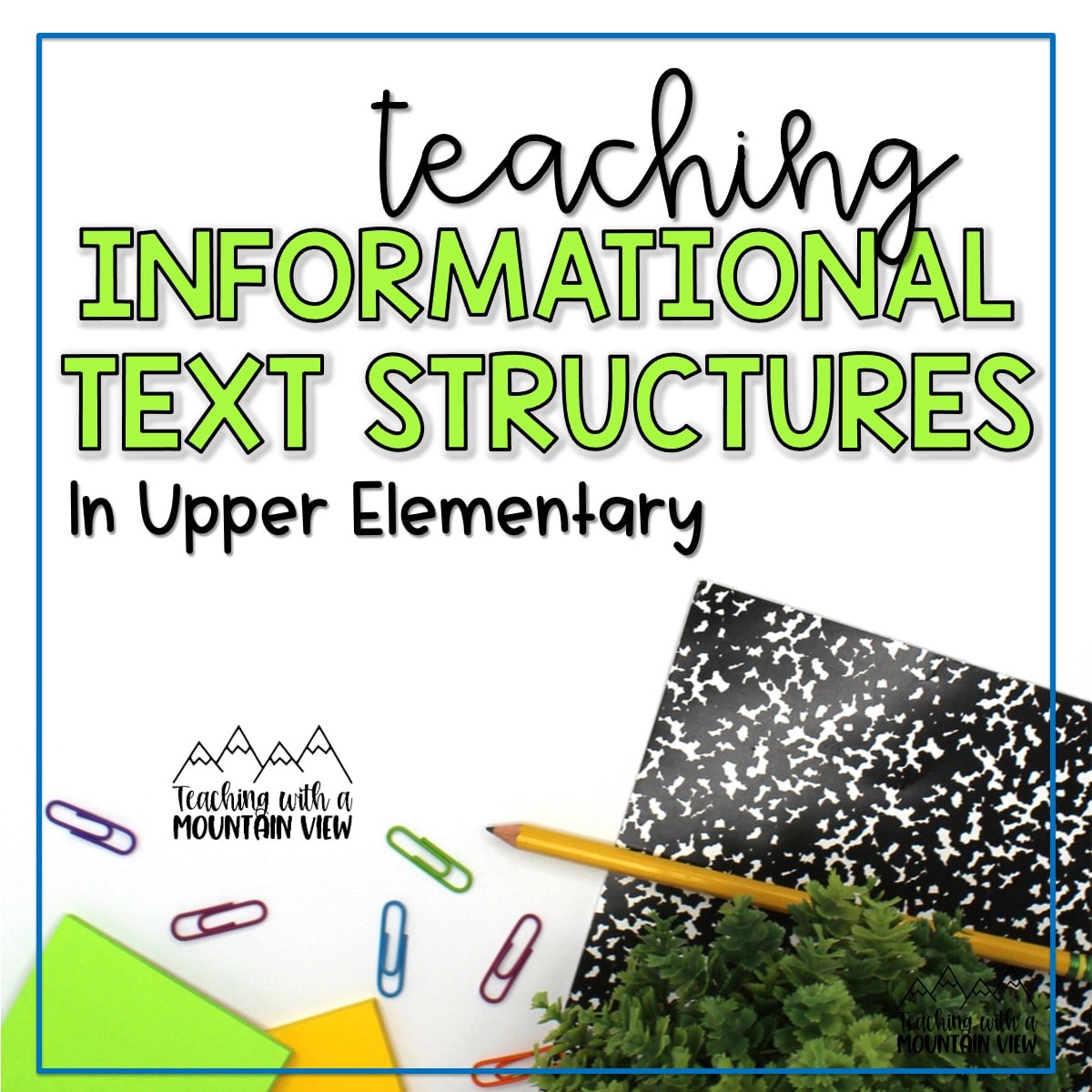
I have spent the past week working on Informational Text Structures with my 5th graders. I was shocked to discover that this was almost an entirely new concept for them, so we did several fun little activities to solidify the concept. This week, they are working on their cumulative project, creating a mini-magazine about a topic of their choice with all the text structures present and a whole myriad of different text features, too. I can’t wait to see their final products!
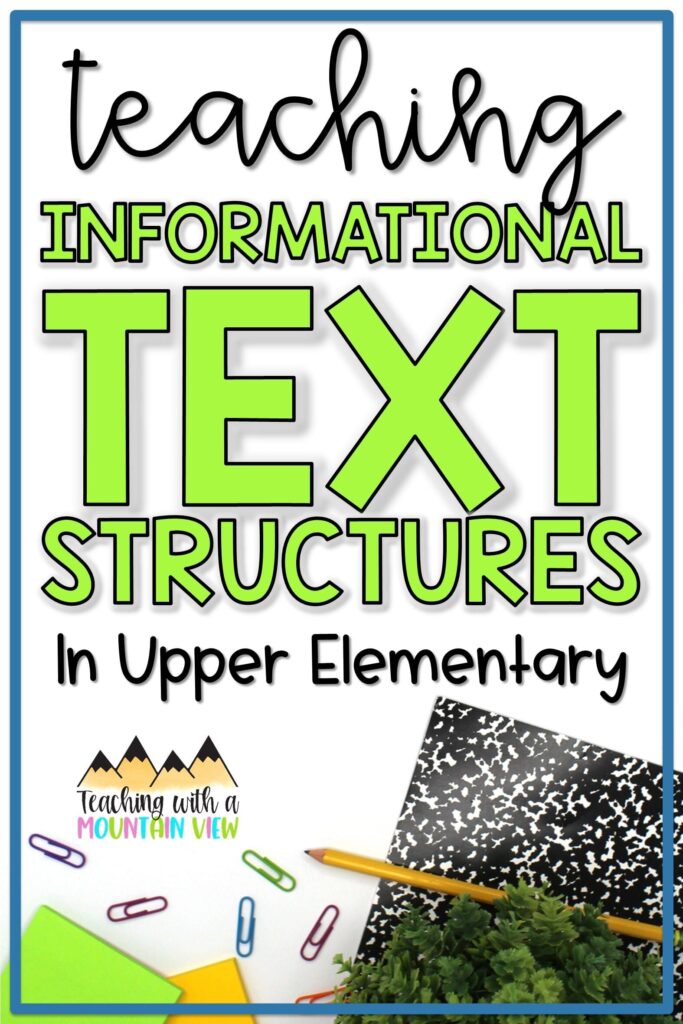
Brainstorming Informational Text Structures
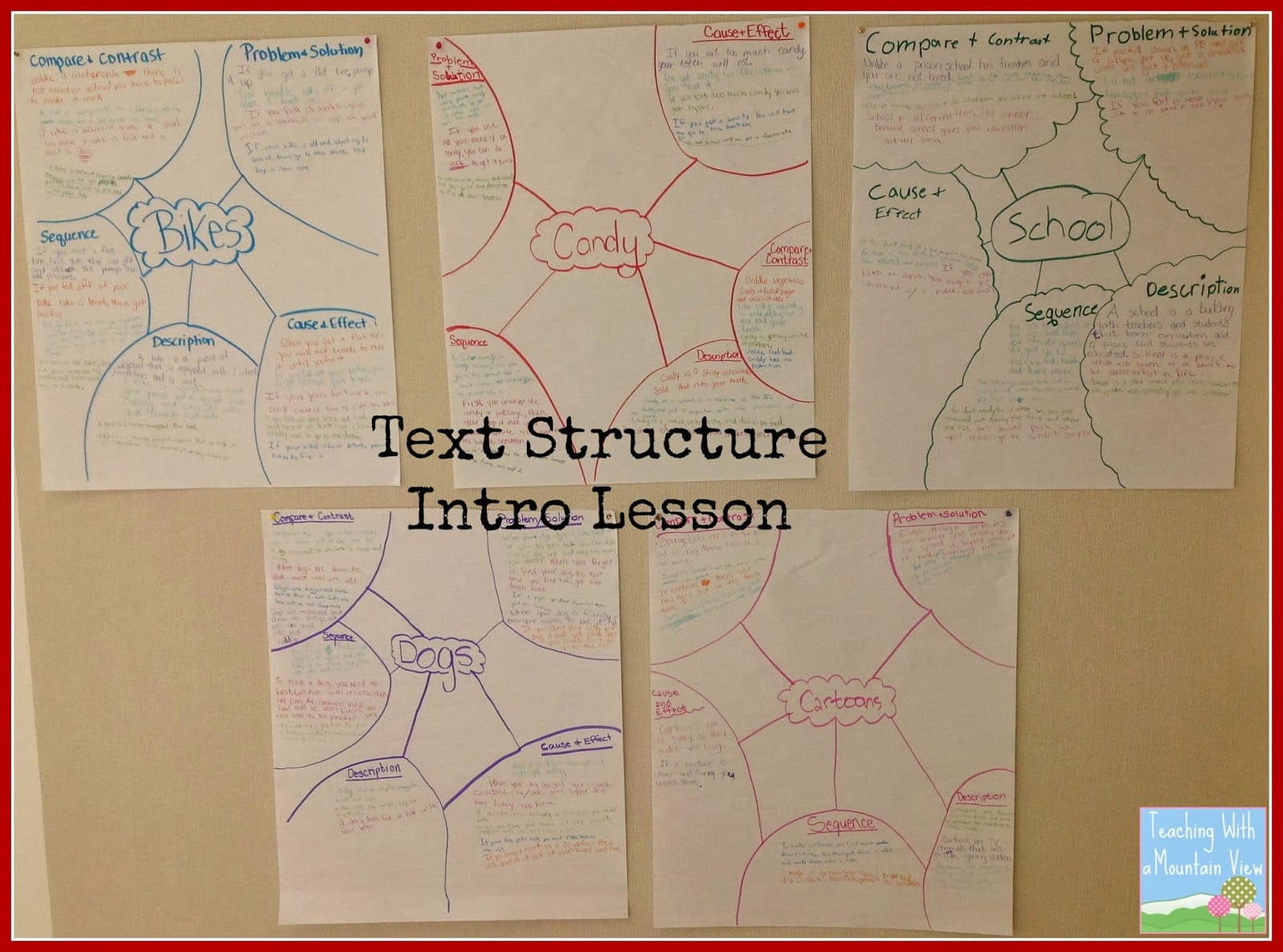
We began the unit by doing a carousel activity. All of my students KNOW what each of the structures means because we spend a lot of time reviewing the concepts during reading. I had them brainstorm five different topics that they could write information about. Then, they divided up a piece of chart paper into a section for each of the types of structures. They got to work writing short sentences that fit the specified type of structure. (At this point, I didn’t even use the term “structure.” I just told them to write an informative sentence that shows each relationship.) They did a GREAT job with this! It would also be a great assessment or mid-unit activity.
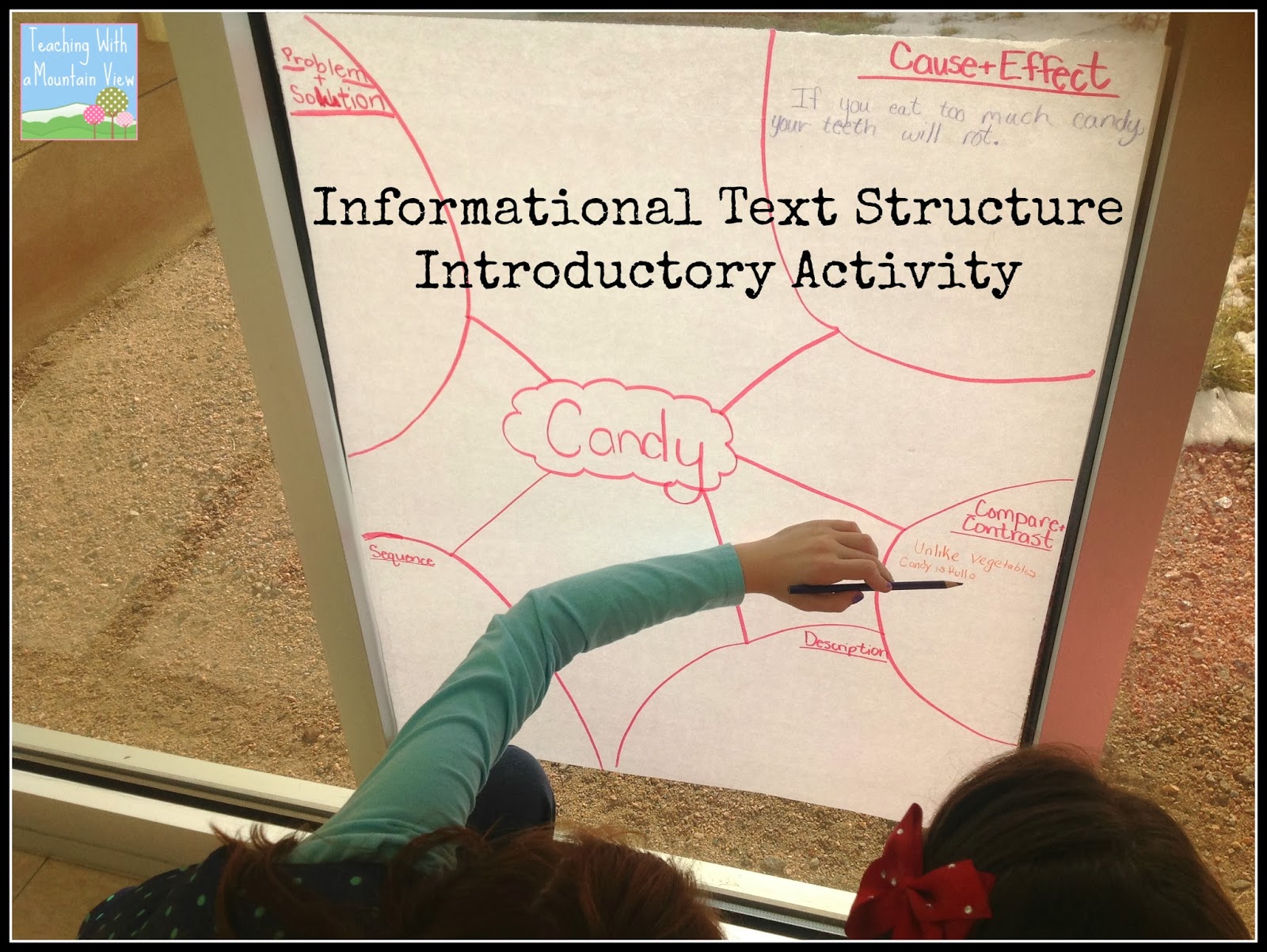
Informational Text Structures Anchor Chart and Foldable
We make an anchor chart to use as a visual reference throughout the unit.
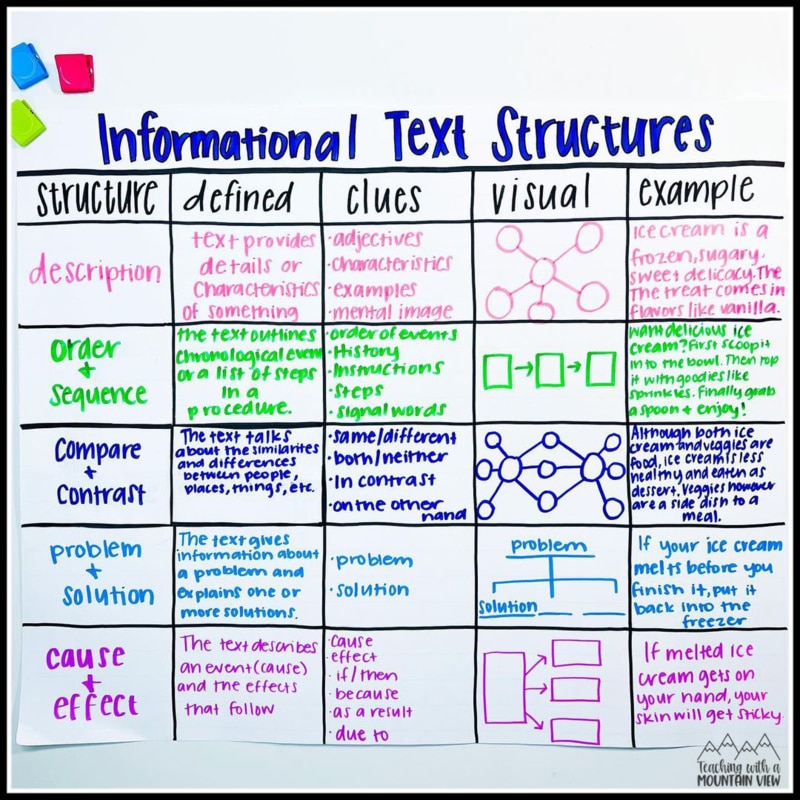
You can also use these informational text structures anchor chart templates to make your anchor chart and reference sheet process even easier!
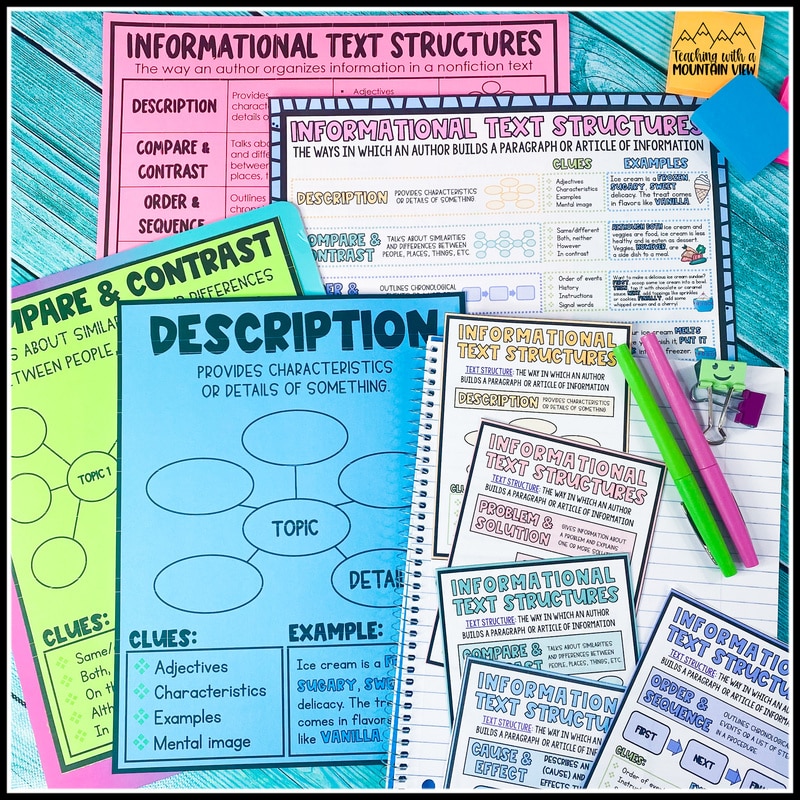
This ready-to-go lesson informational text structure slide show is another way to streamline your lesson planning! Your students will love learning about text structures with these high-interest lesson slides and the accompanying slide guide.
We also make an Informational Text Interactive Notebook (which I LOVE and believe every upper grades teacher should own) that gives a great overview of all of the different text structures. We discussed the etymology of the word “Structure” and that helped the students understand that Informational Text Structure is the way in which an author builds a paragraph or article of information. I created an anchor chart while they made their foldable.
ADDED: Here is a picture of how our foldable ended up looking for the 2015-2016 school year.
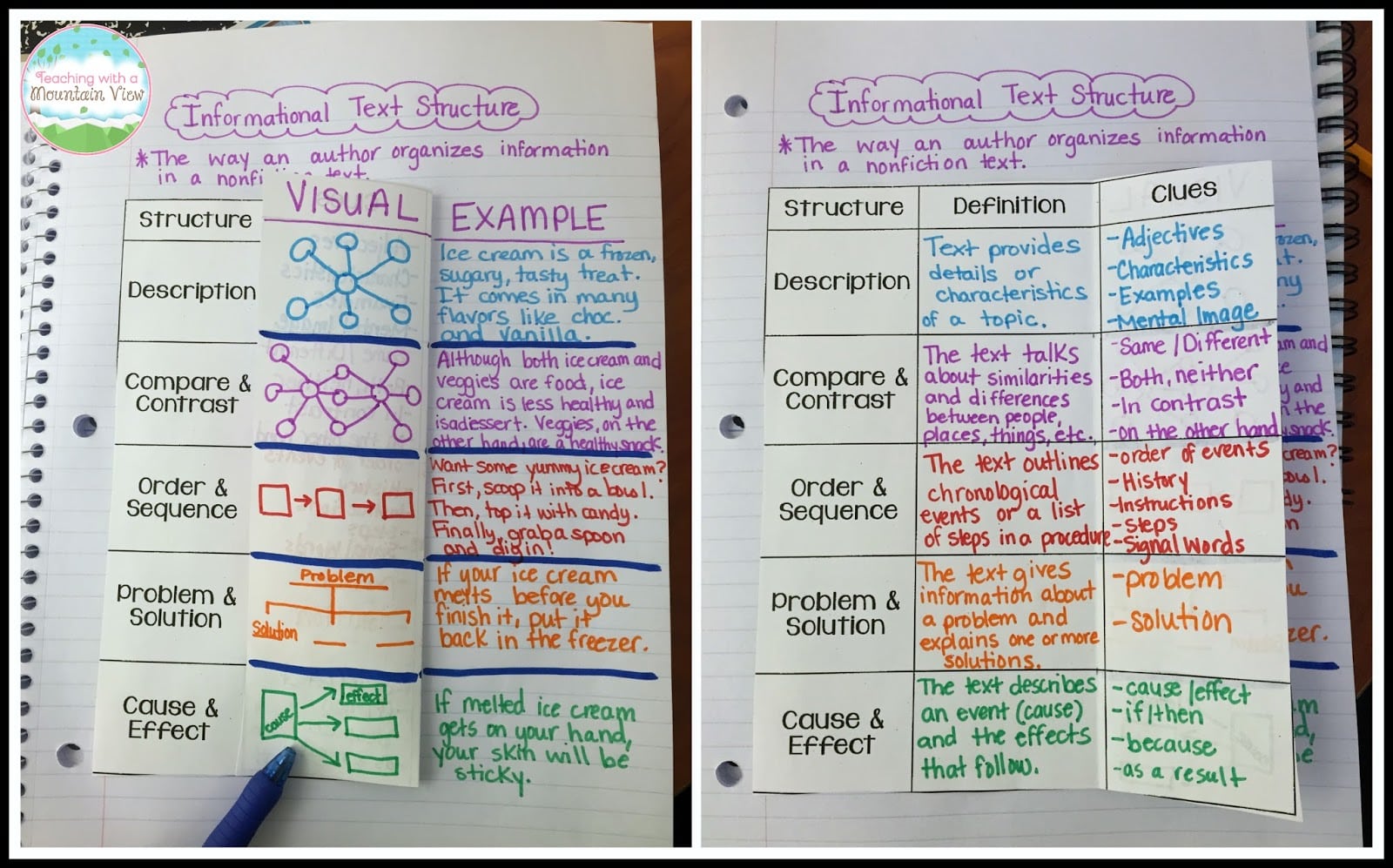
We are a Thinking Maps school, so my visuals were a little bit different than some others I have seen. We also generated an example (about ice cream, of course) for each structure. I can’t tell you how many times the students have referenced this anchor chart while working on other assignments throughout the week. It looked busy to me at first, but it’s full of information that the students seem to find useful.
Free Informational Text Structures Sort
I also created a FREE text structures sort that includes short, one or two sentence descriptions that fit into each structure. The themes are super fun– video games, swimming, chocolate chips, and fast food. I like to laminate the pieces and have students complete them in partners. It also includes a digital version!
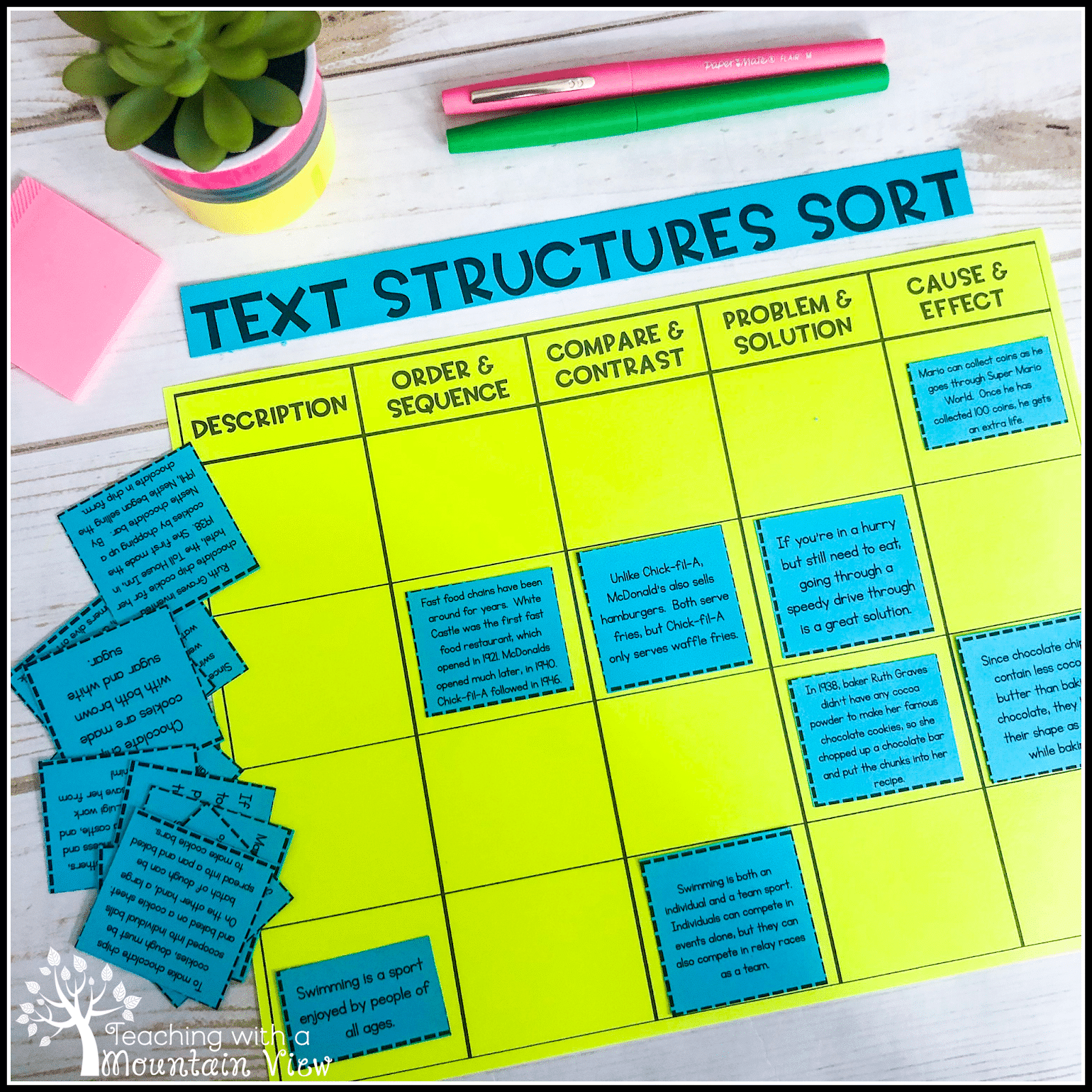
Grab your FREE Text Structures Sort!
Subscribe to get my latest content by email and you will automatically receive your free text structures sort.
Success! Now check your email to begin your download.
There was an error submitting your subscription. Please try again.
Interactive Notebook Examples
Throughout the rest of the week, we completed an individual lesson and foldable from the Interactive Notebooks each day. Erin from I’m Lovin Lit has included separate paragraphs and lessons for each different structure which helped to solidify understanding each of them.
Have I mentioned how much I love these?! Erin was also sweet enough to send me 5 extra free paragraphs about Alcatraz to use with my students. My students were FASCINATED by these paragraphs, and they are perfect for the older crowd. You can download these for FREE , thanks to Erin at I’m Lovin’ Lit . If you haven’t already, check out her blog for more great ideas!
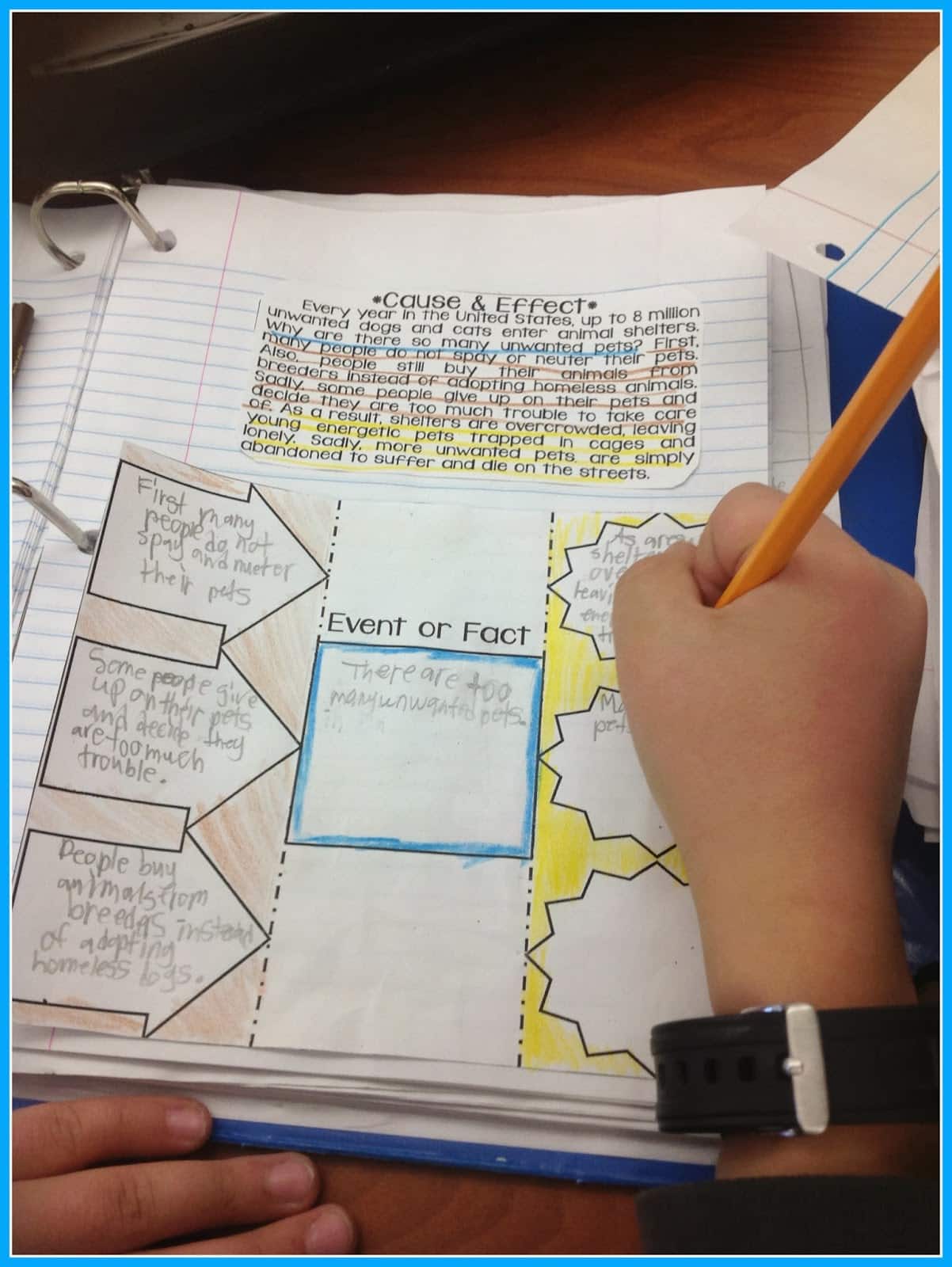
I also use this text structure flip book . On the right-hand side of each section, there is a carefully crafted informational text passage. On the left side of each section of the flip book, students complete several text structure tasks. For example, there is one section that focuses on description, one that focuses on sequence, etc. There is also a comprehension quick check question for each section of the story. Students should complete the entire resource over the course of several days. The final task asks them to put all of their reading skills together to write a summary of the information.
Informational Text Structures Practice Activities
After we did the foldables, they worked on some informational text structure task cards that I created. These task cards were quite the labor of love to create! I was under a time crunch to get them done since I needed to use them in my class, and each one seemed to take me forever to make. The cards include three different paragraphs, written in a different structure, about one topic. I also included comprehension questions on each card since we were working on some other nonfiction comprehension topics as well. The kids really enjoyed these and looked forward to completing their required two each day.
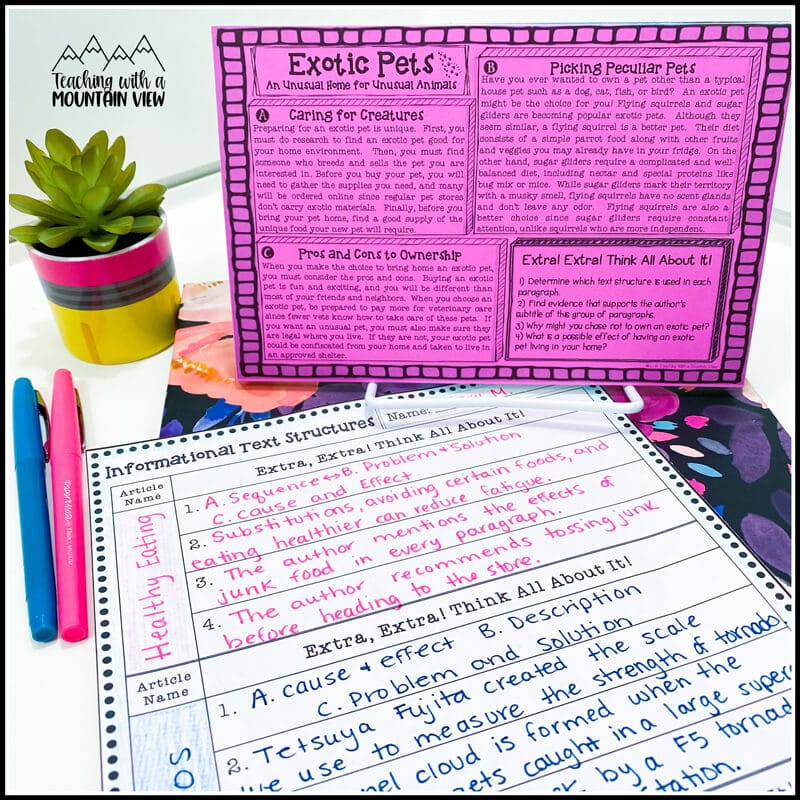
UPDATE February 2017: I used these cards with a little twist this time around! After we had created our foldable and gone through each of Erin’s paragraphs, I gave pairs of students a copy of one of the informational text structure task cards. Then, I had them identify which text structure each paragraph was written in and organize the information in the paragraph using the correct visual Thinking Map that we had discussed. This was such a powerful learning experience! Some students made mistakes in identifying which structure a paragraph was, and when they tried to organize the information in a visual model, it didn’t work! They were able to self-correct so seamlessly. Here are some pictures of the work:
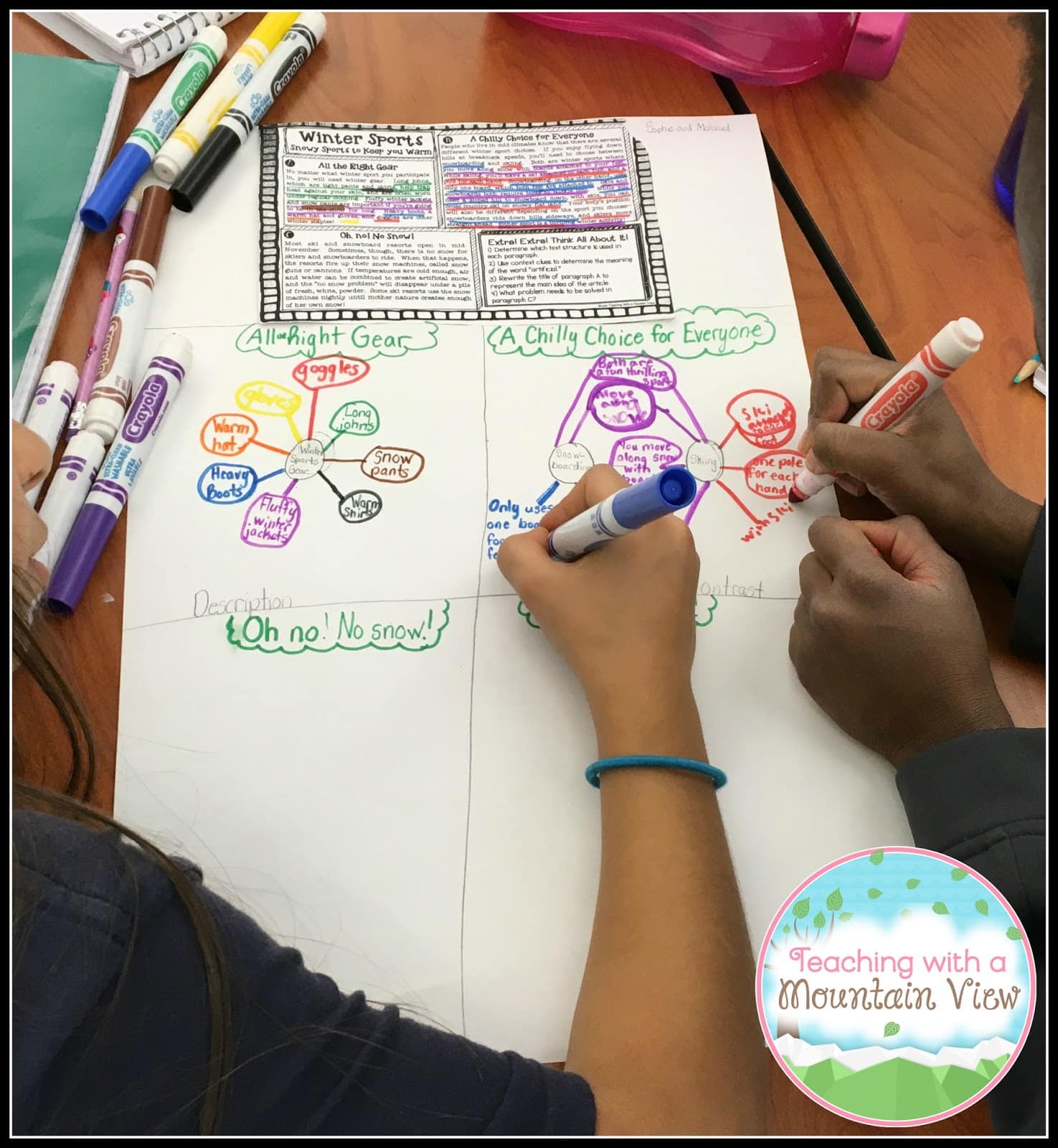
You can purchase these Informational Text Structure Task Cards at my TpT store HERE . They now include the task card version, a printable version, AND a digital version! The possibilities are truly endless.
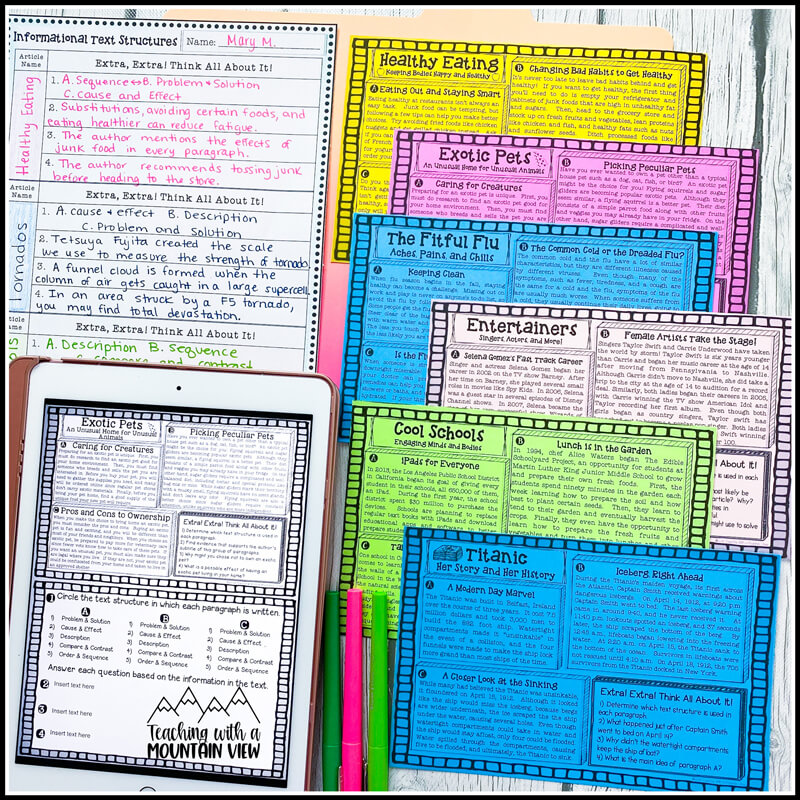
If your students aren’t quite ready for this much text, the resource also includes individual passages. I use them as a text structures sort activity! This is perfect if you have already completed the smaller, easier sort above.
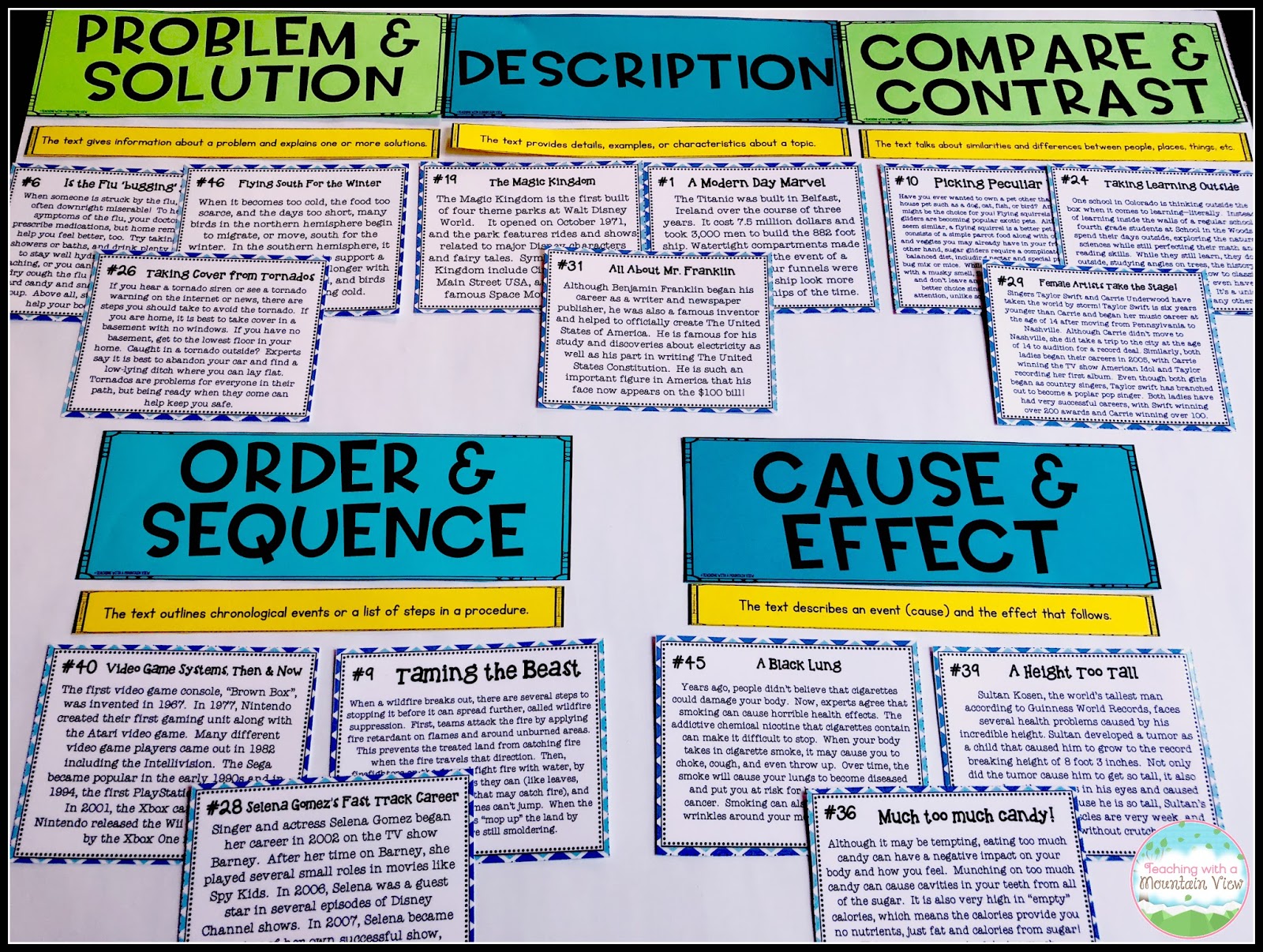
These Using Pictures to Teach Informational Text Structures pages are another way to help students become confident in using and identifying the following text structures through short reading passages: description, order & sequence, cause & effect, compare & contrast, and problem & solution . Each text structure includes the following pages:
- 1 informational reference page to introduce the text structure and provide keywords, text-marking strategies, and a graphic organizer
- 3 practice pages using pictures where students will get hands-on practice using and identifying the text structure
- 1 paragraph practic e page to help students brainstorm a text structure-specific paragraph using a graphic organizer.
Informational Text Structures Leveled Passages
These leveled informational text passages provide the perfect way to differentiate your instruction and engage your students in meaningful reading comprehension.
Each set of 7 leveled passages has been carefully created to allow students to apply critical thinking as they explore text structures. The seven engaging and original texts come in three different levels, each with corresponding annotation reading comprehension activities. The questions are the same or similar for each level passage so all students receive the same deep level of comprehension practice.
Informational Text Structures Reading Projects
Update 2018: I have really been digging reading projects lately, as my students are always so engaged in them. I created this super fun informational text structures reading project that has a racing theme. There are fifteen pages of printable resources to practice the ins and outs of text structures, and it is just so much fun! You can view the project and learn more about it HERE .
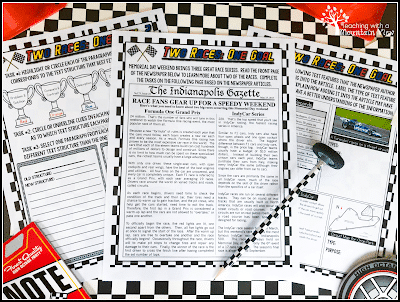
UPDATE: Here is a link to my blog post about our Text Structures Final Projects!
Since then I’ve also created these new Informational Text Structure brochure projects . Your students will become the newest “employees” of the coolest brochure designer in town. After reading informational text passages (two per location) about one of five locations, they will create a new brochure for each location using their super text structure skills! Students will be given a guided brochure template with specific questions pertaining to the passages and informational text structures. They can simply create the brochure using the template, or they can create a brochure from scratch and fill it out using the info on the template!
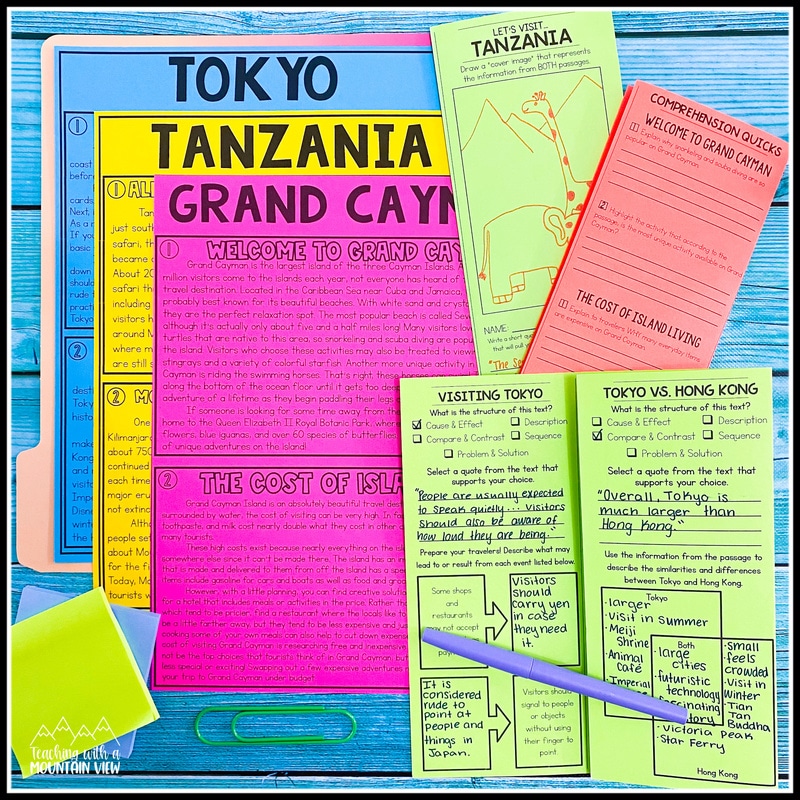
Finally, we are taking an assessment of each of the structures. I based my assessment on the task cards we used, and it is a good way to gauge student understanding. You can download my informational text structures assessment for FREE at my TpT store .
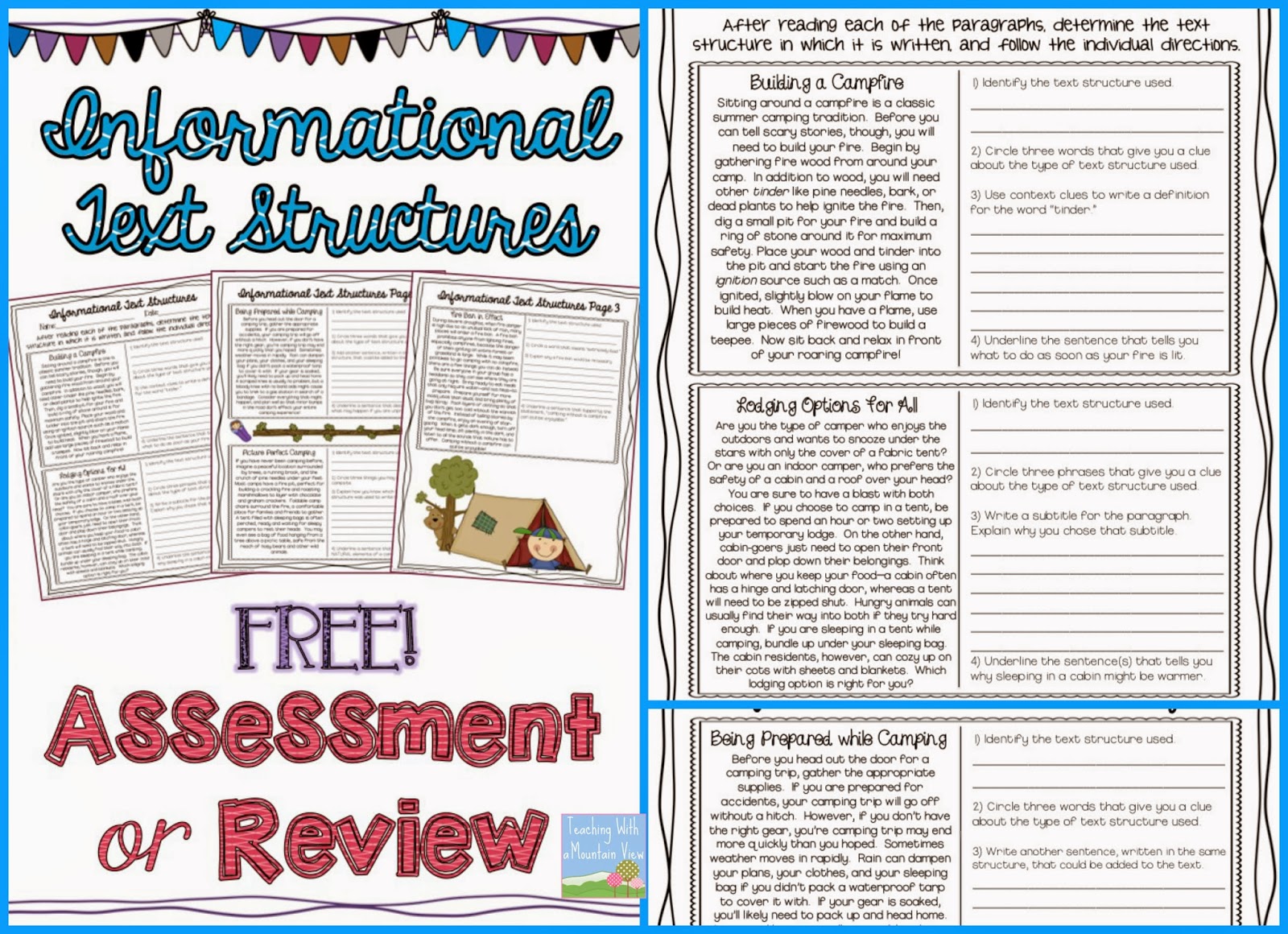
I can’t wait to see the final projects that my students are working on! It should be a great display of their learning and of the common core standards we have been focusing on.
Informational Text Structures Bundle
When you need it all, this Informational Text Structures Bundle is jam-packed with engaging and rigorous ideas to teach students all about informational text structures. Each activity uses high-interest topics to ensure that students are engaged and ready to learn! It includes a nchor chart templates, task cards, a Topple Blocks game, the reading project, the flip book, paired passages, and more!
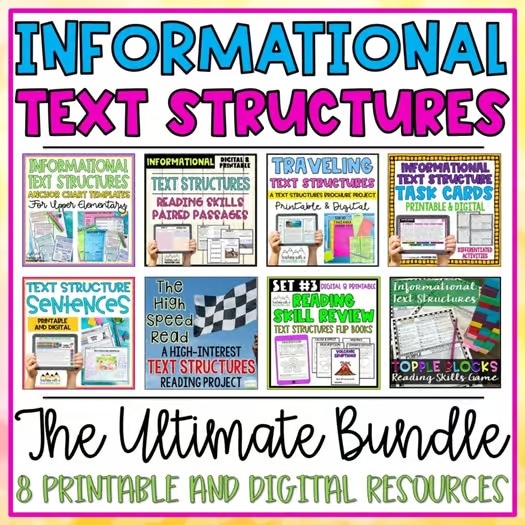
Mary Montero
I’m so glad you are here. I’m a current gifted and talented teacher in a small town in Colorado, and I’ve been in education since 2009. My passion (other than my family and cookies) is for making teachers’ lives easier and classrooms more engaging.
You might also like…

Leave a Reply Cancel reply
Your email address will not be published. Required fields are marked *
38 Comments
What a way to help them understand Information Text.
Just in time! I'm starting on this with my sixers! Thanks for sharing.
I just finished this section with my sixth graders/ and so LOVE Erin's INB's. I have both NF and Fiction. I will use your task cards as a review/and the assessment you put in too! Thanks so much!!!!!! I love the big charts with a topic and then they have to write in the five different ways! 🙂 GREAT IDEA!
I absolutely love these! I really could have used them this year… my kids were having a hard time with text structures! I added your task cards to my wish list on TPT… I must have these for next year! Love it!
Thanks for sharing, Amanda My Shoe String Life
In the event this were being soccer, playing baseball. eight hundred would be regarded stratospheric Männergruppen
Hi Mary! I was so excited to see this post! We've been working on text structures too and I was also surprised at how little they knew about the structures when we began. I love your anchor chart! I made some posters for my class (will try to share them soon) that we've been using this past week. Off to purchase your task cards 🙂 🙂
I'm thrilled I came across your post on informational text this morning (thanks to Pinterest!) as I'm starting the informational reading unit with my 3rd graders tomorrow! I love how you organized it, you've given me some wonderful ideas to adapt for my kiddos! Thank you so much!
Very well organized!!! Thanks for sharing.
I love this anchor chart. I am a flipping the classroom teacher (makes videos for teaching new concepts). I used your anchor chart to help prepare for the video. Since this is a new concept with Common Core it really helped me to be able to understand it myself. I credited your website on the YouTube page! Thank you for sharing such wonderful resources! http://www.youtube.com/watch?v=x2I_6SrOMes
The versatility of our writers enables us to offer and deliver a wide range of services and all types of papers.Let us know at here https://www.topessaywriting.org/ We have hired talented writers from all fields of study, and they are capable of completing any type of academic paper you need.Thanks
You're a genius! I truly love how involved the students are throughout the lesson! Thank you for sharing your ideas!
Great wotk! Do you need professional essay writing help?
Hello!) Once we have learned about text structures in my college. And then I have to write an essay. Ordered it I here http://www.best-essays-writers.com .
Interesting post. By the way, students do not have to worry anymore about writing essays. Using first-rate custom essay writing service, that are available 24/7, learners will always get professionally written essays.
Great post. You know, that writing an essay is not easy, especially if you don't have good writing skills. That's why many students are looking for professional writing help online, so buy college essays online is what you are looking for.
This post is really interetsing. Thanks for it. If you want to get well-written essays at reasonable prices, go to http://essaywritingstore.com .
Given so much info in it, These type of articles keeps the users interest in the website, I found it here, today I am feeling glad after finding this precious post.Thank uResume writing services in Dubai
Most students in schools and tertiary educational background position organizations would commonly want essay help online with regards to their essay jobs would regularly examine internet expert services whereby those people students could purchase them.
This was an excellent post. It has some valuable info on this topic. Thank you for compiling it into an easy to read and well written post. Cheap academic essay help here online!
Majority of students feel nervous and lose confidence when they are asked for writing some essays and presenting before others. If you are one of them then kick away this condition by getting the best custom essay writing service ever for preparing your papers without mistakes and within your cost.
People would order custom written essay about this good topic, choosing the essay writing services. You definitely will need use plagiarism checker. Now, you don’t have to worry about getting a failing mark simply because you have been accused of plagiarizing someone else’s work.
Hello, just wanted to say, I loved this article. It was practical. Keep on posting! — juegosjuegos.com | jogos do friv | juegos de matar zombies
I found it quiet interesting about Best Admissions Essay Help,Thank you for posting the great content…I was looking for something like this…, hopefully you will keep posting such blogs…
http://www.essaytyper.com/
WOW! what a beautiful plus attractive Informational Text Structure, i have never seen before. Nice Sharing Custom Assignment Writing
You have a real ability for writing unique content. I like how you think and the way you represent your views in this article. I agree with your way of thinking. Thank you for sharing. unblocked games| unblocked games at school| unblocked games| friv4school| friv 4 school| call of duty| tetris unblocked| friv games| frivgames| barbie games| barbiegames| monster high games| kizi2| kizi 2
I also want the time back cool math 4 kids , descargar whatsapp , cool maths 4 kids , descargar whatsapp para android , unblockedgames , unblockedgames
Thanks for the best blog.it was very useful for me.keep sharing such ideas in the future as well. Thanks for giving me the useful information. I think I need it! pacman games |happy wheels games |little pony games | unblockedgames friv 4 kizi4| unblocked games unblocked games for kids madness project nexus hacked happy wheels hacked
Great post. i like it. feeling great when reading your post . Signature: Versión en facebook en español descargar a los países hablan Español: facebook entrar direto agora , facebook en español descargar , facebook entrar direto agora
cheap oakley sunglasses ray ban sunglasses michael kors handbags ray-ban sunglasses coach outlet oakley sunglasses outlet chi hair strighteners christian louboutin outlet pandora uk nfl jerseys burberry handbags louis vuitton ralph lauren mont blanc mountain copy watches jordan 3 retro coco chanel hollister outlet gucci outlet oakley outlet hogan outlet kate spade totes kobe 8 cheap oakleys gucci bags michael kors outlet louis vuitton michael kors ray ban eyeglasses hollister clothing store ray ban sunglasses jordan 4 retro cheap ray bans abercrombie outlet jordan 6 cigar 20150626xiong
The best quality custom papers online! http://supreme-essay.net/
Posts shared useful information and meaningful life, I'm glad to be reading this article and hope to soon learn the next article. thank you http://cekkesehatan.blog.fc2.com http://bacakesehatan.drupalgardens.com
Thanks for sharing your info. I really appreciate your efforts and I will be waiting for your further write Packers and Movers Hyderabad Packers and Movers Bangalore Packers and Movers Pune Packers and Movers India
Thanks for sharing. I hope it will be helpful for too many people that are searching for this topic. Packers and Movers Delhi Packers and Movers Gurgaon Packers and Movers Mumbai
Thanks for all your information.Website is very nice and informative content. Packers and Movers Bangalore Packers and Movers Gurgaon Packers and Movers Hyderabad
Thanks for all your information.Website is very nice and informative content. Packers and Movers Pune Packers and Movers Chennai Packers and Movers Delhi
ugg uk nike free gucci outlet hollister shirts coach outlet store evening dresses christian louboutin outlet michael kors outlet , http://www.michaelkorsoutletcanada.in.net san antonio spurs jerseys lululemon cheap jordans , http://www.jordan-shoes.us.com kate spade handbags nike huarache coach outlet online yoga pants , http://www.yogapants.us.com the north face outlet store pandora charms air max 2014 burberry outlet online michael kors outlet , http://www.michaelkorsoutletonlinstore.us.com beats headphones babyliss pro instyler prada shoes kate spade outlet tory burch outlet lacoste shirts lebron james shoes stuart weitzman boots michael kors canada , http://www.michaelkorsoutletcanada.in.net babyliss oakley sunglasses , http://www.oakleysunglassescanada.com fred perry sale green bay packers jerseys coach outlet canada nike roshe run jordan 4 atlanta falcons jersey kate spade outlet 0811maoqiuyun
I love all of your ideas. I am always looking for new ideas on text structure. I am teaching text structure next week and plan on trying some of these. I am curious about the sequence of the activities that you did during the week.

©2023 Teaching With a Mountain View . All Rights Reserved | Designed by Ashley Hughes
Username or Email Address
Remember Me
Lost your password?
Review Cart
No products in the cart.

IMAGES
VIDEO
COMMENTS
Purpose of informative writing. The purpose of an informative essay depends upon the writer's motivation, but may be to share new information, describe a process, clarify a concept, explain why or how, or detail a topic's intricacies. Informative essays may introduce readers to new information. Summarizing a scientific/technological study.
A well-written informative essay should include an introduction (hook, bridge, thesis), a body (topic sentence, research, explanation), and a conclusion (reframed thesis and call to action). While ...
Writing Informative Essays. Writing an informative essay is a step-by-step process that should be followed in the right order to get the best results. The steps to writing an informative essay are ...
39 Introduction to Informative Writing . Amy Minervini. Overview. By Amy Minervini. Overview. Exposition is writing that explains, informs, or describes. This type of writing is also known as the informative mode in that the main objective is not to narrate a story or persuade readers of something but rather to convey factual information, including observations and personal/others' experiences.
Writing an Informative Essay Informative essays engage readers with new, interesting, and often surprising facts and details about a subject. Informative essays are educational; readers expect to learn something new from them. In fact, much of the reading and writing done in college and the workplace is informative. From textbooks to reports to tutorials like…
Structure: These essays have a clear roadmap. They start with an introduction to set the stage, then present the main points with evidence, and wrap up with a summary to tie it all together. ... Writing informative essays, whether following the IEEE format or another style, is a great way to teach and share ideas with others. Here's why it's ...
The structures of informational texts | Reading. Text structures are ways to organize writing. Text structures include: chronology, compare and contrast, cause and effect, problem and solution, and description. These structures are like building blocks for texts, and as we understand them, we become better readers. Created by David Rheinstrom.
An expository essay should take an objective approach: It isn't about your personal opinions or experiences. Instead, your goal is to provide an informative and balanced explanation of your topic. Avoid using the first or second person ("I" or "you"). The structure of your expository essay will vary according to the scope of your ...
The basic structure of an essay always consists of an introduction, a body, and a conclusion. But for many students, the most difficult part of structuring an essay is deciding how to organize information within the body. This article provides useful templates and tips to help you outline your essay, make decisions about your structure, and ...
The purpose of informative writing is to share information without any opinion or bias. In informative writing, there's no room for your personal insights, feelings, and attitudes about the subject. The task is clear: educate the reader by conveying factually accurate and relevant information. It may be presented in the form of an essay, an ...
Informational writing is a cornerstone of nonfiction writing, and it usually always involves a coherent thesis statement. Expository pieces, such as something a journalist or whistleblower might write, is another great example. ... Make sure your article has a clear structure: introduction, body, conclusion. Write short, concise sentences ...
Jan 30, 2020. Informational text structures are the organizational patterns all writers must learn. Most people read and write for informational purposes, so it's imperative that we teach our students these building blocks of writing. Before we get started though, I want to talk about the differences between text features and text structures.
How to Master Informational Text Writing in a Single Week. Lesson Plan 1: Introduce the Text Structure. Lesson Plan 2: Research. Lesson Plan 3: Plan & Organize. Lesson Plan 4: Write. Lesson Plan 5: Edit and Proofread. START HERE FIRST.
This contest asks students to choose an issue or question in science, technology, engineering, math or health that interests them, then write a 500-word explanation that will engage and enlighten ...
Text structure is how the author organizes the main body of text in an informational text. The five main informational text structures are: sequence, problem/solution, description, compare and contrast, and cause and effect (refer to the Comprehension at a Glance Documen t for a review of these structures). Students must be explicitly taught about the different types of text structures, so ...
To inform. To tell a story. To achieve these purposes, authors use one or more of the following 5 text structures: Description. Sequence/Instruction/Process. Cause/Effect. Compare/Contrast. Problem/Solution. Students must be able to unpack these 5 text structures and study their components in order to fully understand and analyze informational ...
The Informational Text Structure. Understanding how to structure an informational piece is crucial. The typical structure includes: 1. Introduction - The introduction aims to grab the reader's attention and provide an overview of your discussion. It's where you'll include your topic sentence, clearly stating your main idea.
Informational Writing Structure. Students are now ready for the informational graphic organizer. Each feature of the informative writing learned earlier fits nicely in the graphic organizer. (For some reason, students are shocked by this demonstration.) To take it a step further, hand out the Informational Writing Rubric.
• Writing • Speaking and Listening, and • Language. With the implementation of the Common Core State Standards (CCSS), it is expected that students in grades K-5 will have access to and instruction involving 50% informational text and 50% literature within their classrooms. The CCSS emphasize four types of informational text:
Informational writing is factual, nonfiction writing that conveys information about a topic. Examples can be found in newspapers, almanacs, and reference books. Examples can be found in newspapers ...
Each text structure includes the following pages: 1 informational reference page to introduce the text structure and provide keywords, text-marking strategies, and a graphic organizer. 3 practice pages using pictures where students will get hands-on practice using and identifying the text structure.